News
The 'Magic' of Certain Mushrooms.
25th November 2021
25th November 2021
The Liberty Cap or Psilocybe semilanceata to use its scientific name is a mushroom that grows in suitable habitats in northern Europe and the Pacific Northwest of the USA.
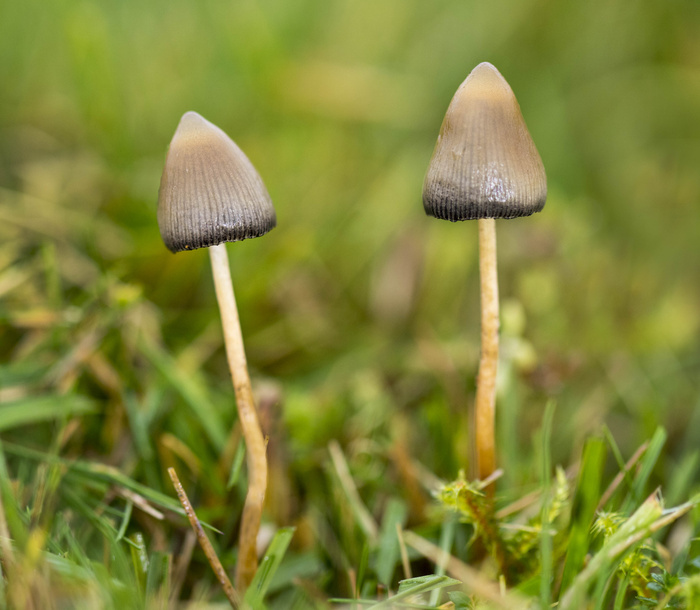
The psychoactive effects of this mushroom have been known for a couple of hundred years but the compounds that were responsible for these effects were only identified in scientific terms in 1958 by the Swiss scientist Albert Hoffman who also more famously synthesised LSD.
It is also known as a ‘Magic Mushroom’ because it contains this psychoactive compound, Psilocybin. This term originates from the ‘Hippie’ days of the 1970’s when these mushrooms were picked and eaten after drying, the resultant feelings of contentment, social happiness and even euphoria made them very popular. In addition there was the added bonus of hallucinations and a general detachment from reality that you could experience - if you like that sort of thing! However, (as a serious warning), some people endured a bad experience after consuming them, irregular breathing and heartbeat, psychotic states, seizures, increased blood pressure and temporary vision impairment. I suppose you never know what effects these psychoactive compounds will have on you until after you consume them – the experience for each individual is very unpredictable.
Up until 2005 before the law was changed it was legal to pick these mushrooms but illegal to possess them after they were dried or ‘prepared’ - this was on the assumption that if you possessed the dried and prepared mushrooms then you intended to use or supply them for recreational drug use – which was illegal. The law in 2005 was extrapolated to include ‘fresh Liberty Caps’ so from then it was and still is illegal to possess these mushrooms in any form and they now fall under the UK Class A drug category, alongside the more infamous, Cocaine, Heroin and LSD etc. For a lengthy psychedelic experience that can last between three and six hours, the average adult only needs a moderate amount, between 1 and 2.5 grams – just a few of these little mushrooms. Over the last two weeks Susan and I have seen quite large amounts during our photographic endeavours. However, unless looked for they remain discreetly hidden in their grassy environment and on reflection that is probably the safest place for them.
Finally I must add a very serious caveat – (never pick and eat any mushroom or plant unless you are one hundred percent sure of its identity).

The psychoactive effects of this mushroom have been known for a couple of hundred years but the compounds that were responsible for these effects were only identified in scientific terms in 1958 by the Swiss scientist Albert Hoffman who also more famously synthesised LSD.
It is also known as a ‘Magic Mushroom’ because it contains this psychoactive compound, Psilocybin. This term originates from the ‘Hippie’ days of the 1970’s when these mushrooms were picked and eaten after drying, the resultant feelings of contentment, social happiness and even euphoria made them very popular. In addition there was the added bonus of hallucinations and a general detachment from reality that you could experience - if you like that sort of thing! However, (as a serious warning), some people endured a bad experience after consuming them, irregular breathing and heartbeat, psychotic states, seizures, increased blood pressure and temporary vision impairment. I suppose you never know what effects these psychoactive compounds will have on you until after you consume them – the experience for each individual is very unpredictable.
Up until 2005 before the law was changed it was legal to pick these mushrooms but illegal to possess them after they were dried or ‘prepared’ - this was on the assumption that if you possessed the dried and prepared mushrooms then you intended to use or supply them for recreational drug use – which was illegal. The law in 2005 was extrapolated to include ‘fresh Liberty Caps’ so from then it was and still is illegal to possess these mushrooms in any form and they now fall under the UK Class A drug category, alongside the more infamous, Cocaine, Heroin and LSD etc. For a lengthy psychedelic experience that can last between three and six hours, the average adult only needs a moderate amount, between 1 and 2.5 grams – just a few of these little mushrooms. Over the last two weeks Susan and I have seen quite large amounts during our photographic endeavours. However, unless looked for they remain discreetly hidden in their grassy environment and on reflection that is probably the safest place for them.
Finally I must add a very serious caveat – (never pick and eat any mushroom or plant unless you are one hundred percent sure of its identity).
Flat on the floor photography.
24th November 2021
24th November 2021
I’ve spent the last couple of weeks lying on the ground photographing fungi, sometimes in a Beech wood and others on open unimproved grassland. It’s quite remarkable the varieties Susan and I have seen. Although we are fledgling fungi finders – (phew, that’s a mouthful), we are enjoying identifying new species very much. However, photographing these fungi is no easy task – not only do you have to carry your photographic kit around but you also have to carry something to kneel and lie on, otherwise you will get quite wet and become covered in mud or worse! In addition lying down and getting back up dozens of times, sometimes from very awkward positions, is tiring. Fungi grow in difficult situations, sometimes where the lighting is poor and others where it is in amongst foliage obstructing your view. A good scissors is very handy for clipping grasses and leaves as is a small LED light on a mini tripod for filling in shadows and general lighting. Ultimately I really couldn’t manage to get any decent images without my Yongnuo twin macro flash, (see review), it is invaluable for this type of photography.
In addition accidental spotting of wildlife has become a bonus - yesterday we flushed two Common Snipe literally from under our feet in a damp grassy area and last week we similarly flushed a Woodcock in a Beech wood.
However, not all fungi are welcome, particularly in your garden and about a month ago we found some Honey Fungus growing on an old stump of a shrub we had cut down.
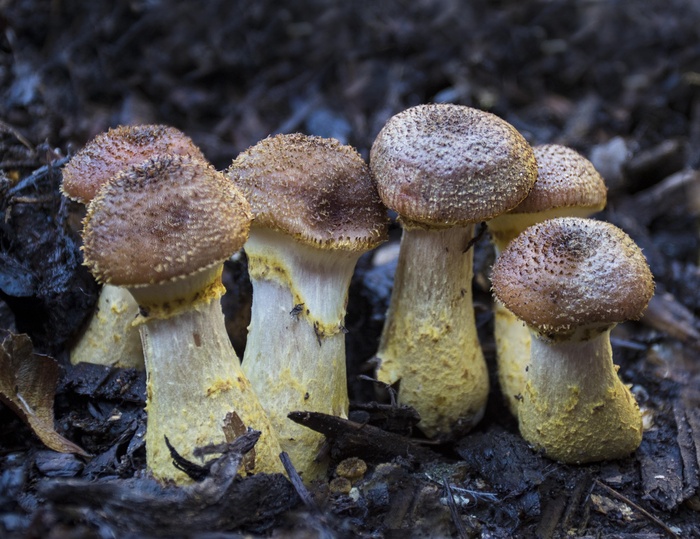
This fungus is bad news for anybody’s garden because it can spread to other trees and shrubs very quickly. We removed it quickly and burnt it because it’s no good just pulling it up and composting it e.g. because it can still release spores and proliferate. Sometimes this removal can be too late because underground the fungus may have already begun to spread to other plants, we will have to see, I hope not!!
This week, however, the first ground frosts have begun and that has been the end of many of the autumn fungi. If we get a mild spell again some more will appear but for now we will have to wait and see.
Below are a small selection of fungi we have seen and photographed.
Raspberry Slime Mould.
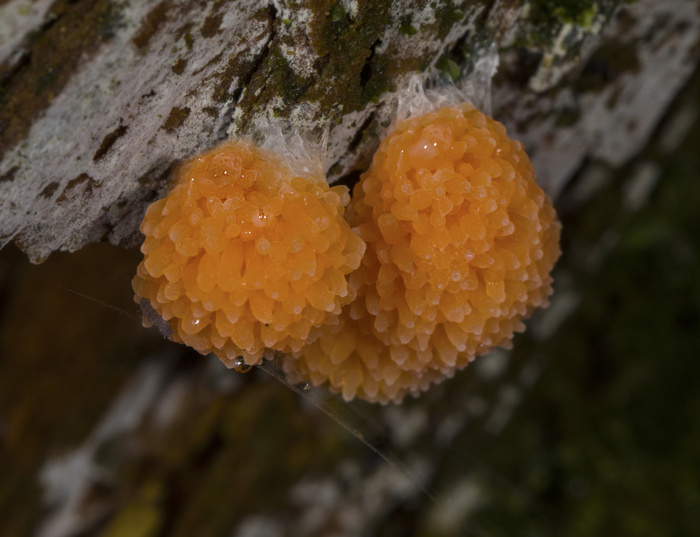
Snowy Waxcap
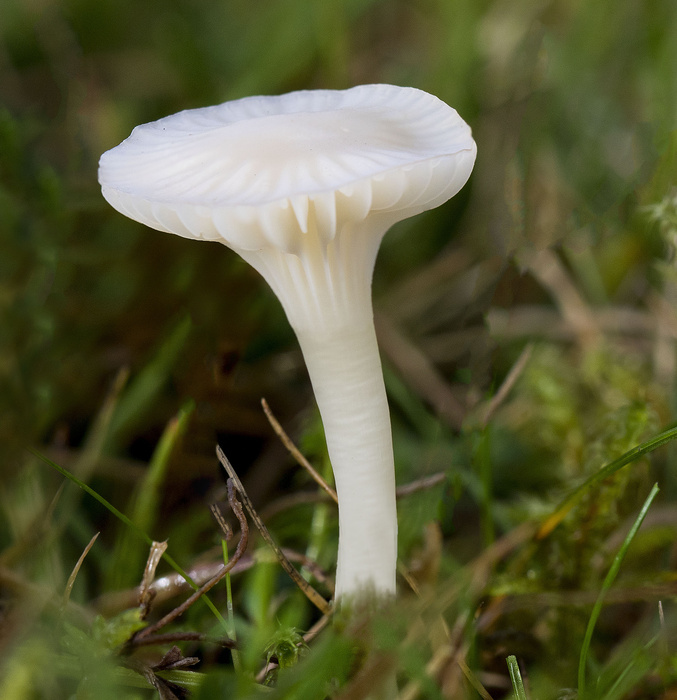
Snakeskin Brownie
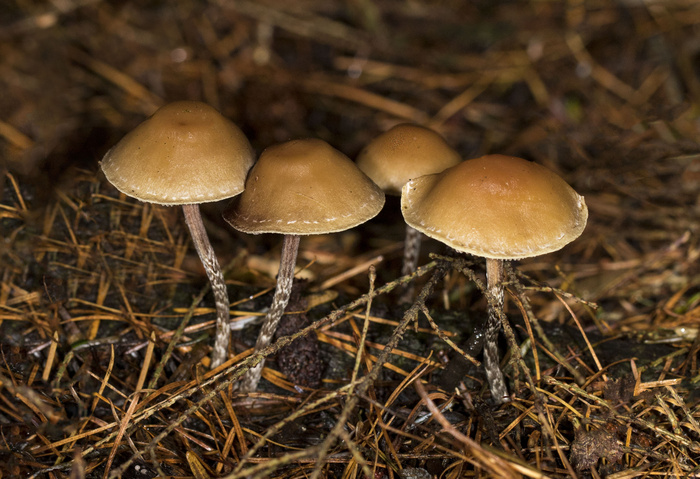
Scurfy Twiglet
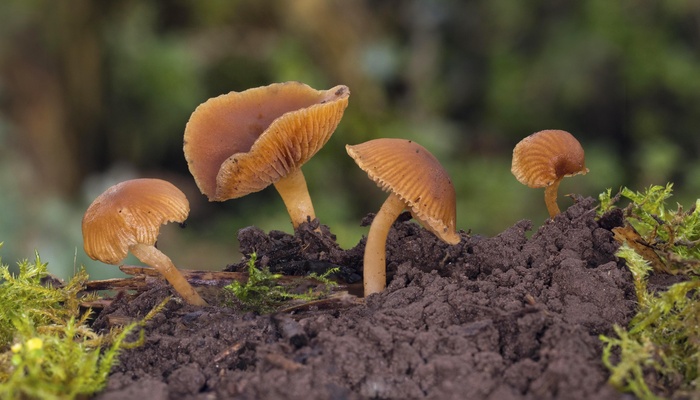
Scarlet Waxcap
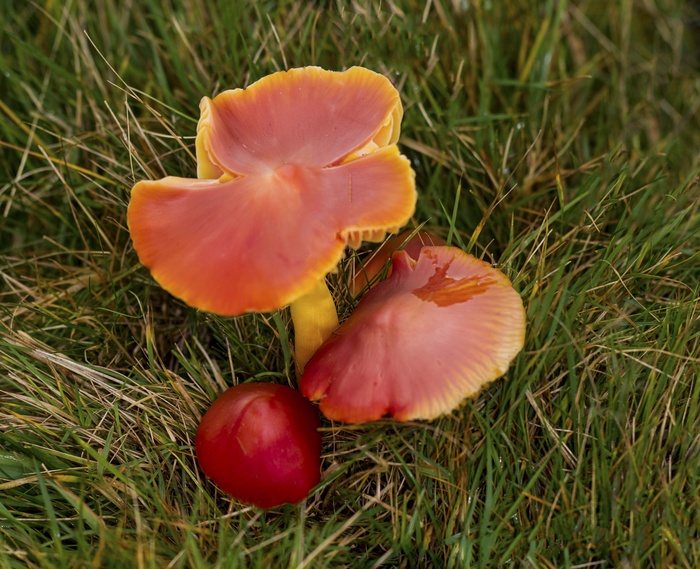
Sulphus Tuft amongst Wood Sorrel
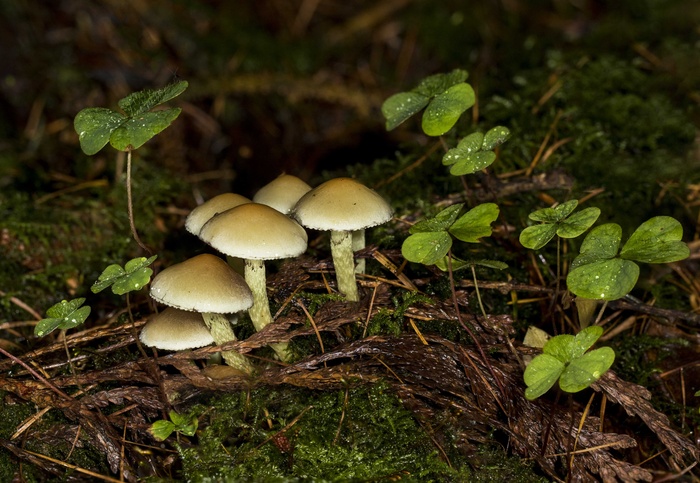
Parrot Waxcap
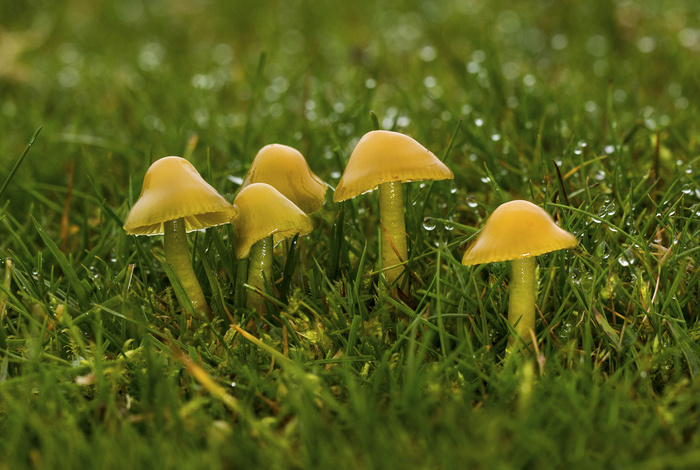
Orange Peel Fungus
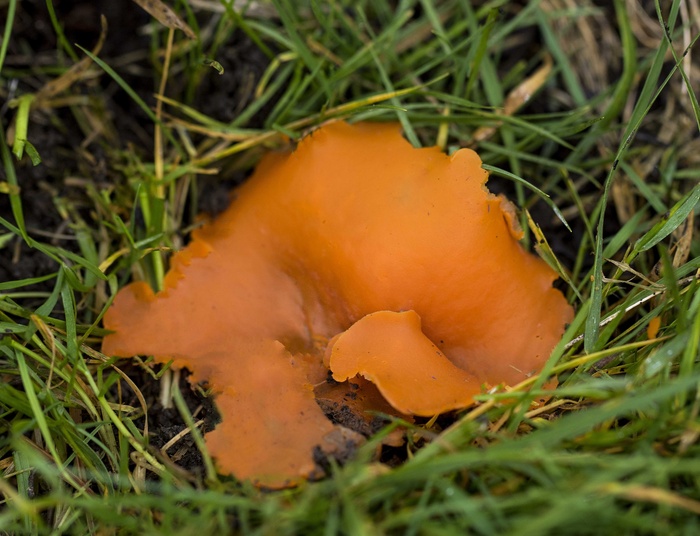
Milking Bonnet
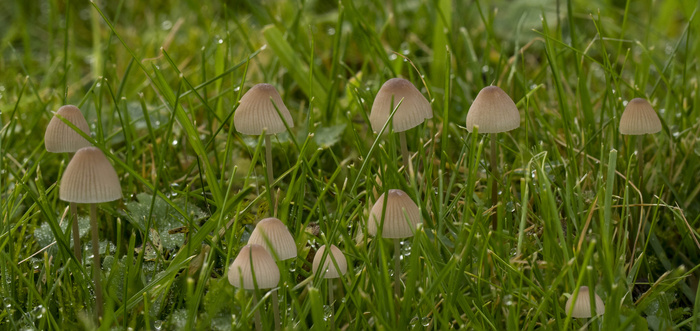
Lilac Bonnet
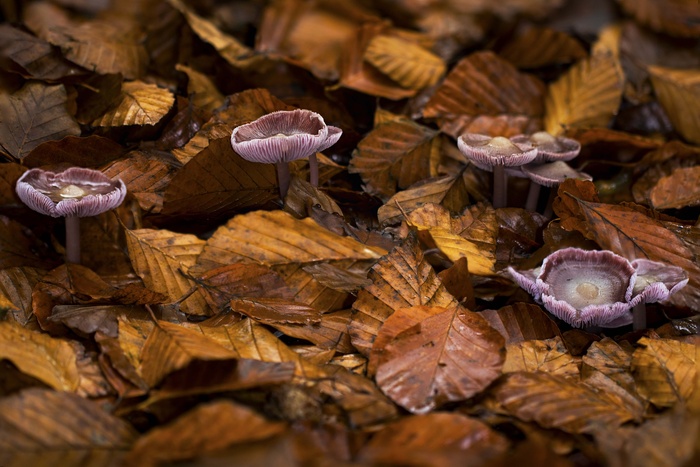
Glistening Inkcap
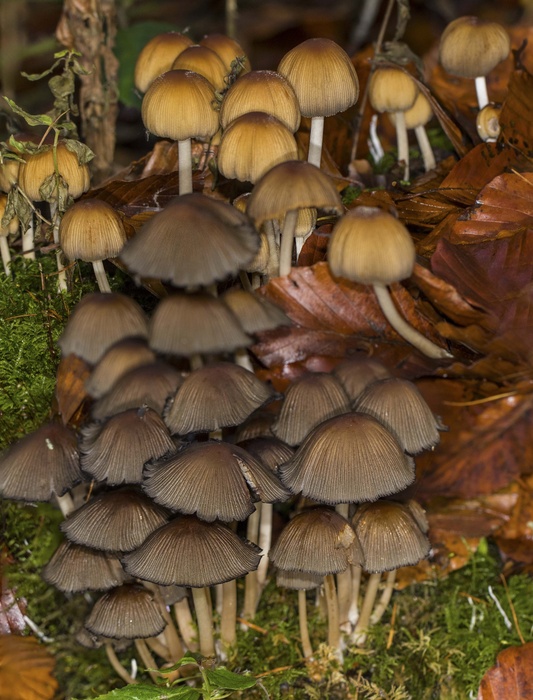
Earthy Powdercap
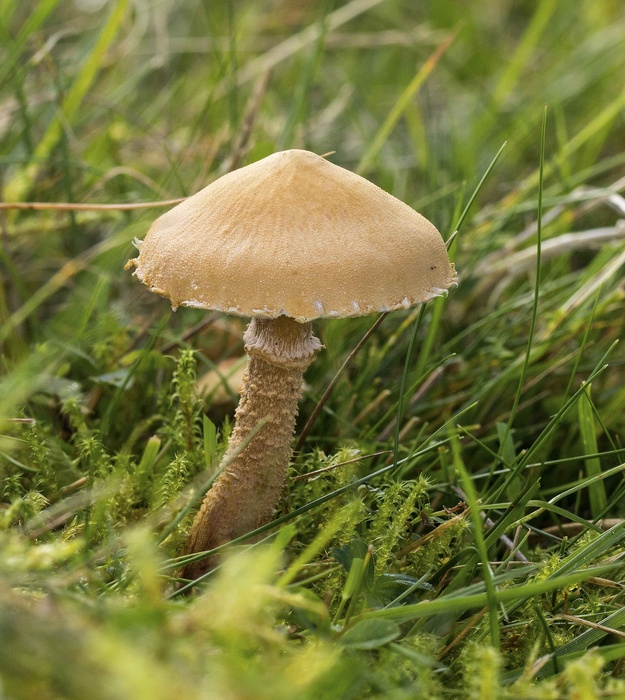
Dappled Webcap
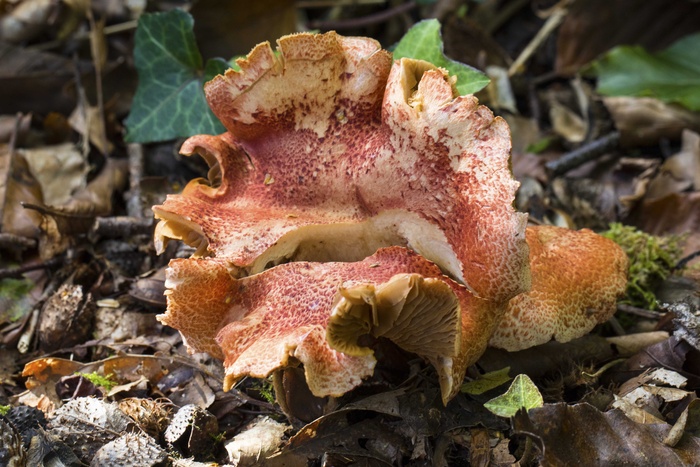
Yellow Staghorn
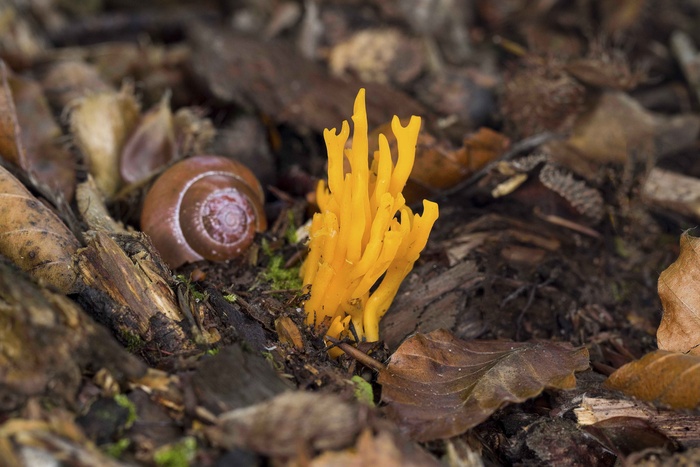
Common Bonnet
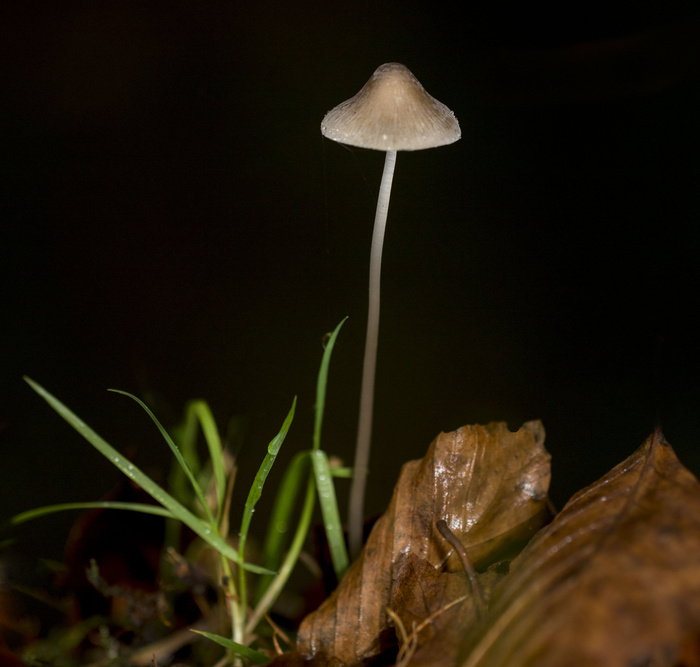
Amethyst Deceiver
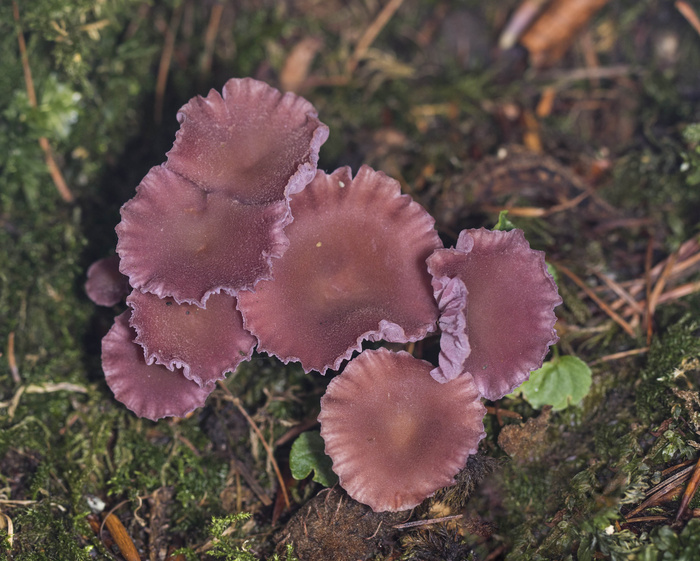
In addition accidental spotting of wildlife has become a bonus - yesterday we flushed two Common Snipe literally from under our feet in a damp grassy area and last week we similarly flushed a Woodcock in a Beech wood.
However, not all fungi are welcome, particularly in your garden and about a month ago we found some Honey Fungus growing on an old stump of a shrub we had cut down.

This fungus is bad news for anybody’s garden because it can spread to other trees and shrubs very quickly. We removed it quickly and burnt it because it’s no good just pulling it up and composting it e.g. because it can still release spores and proliferate. Sometimes this removal can be too late because underground the fungus may have already begun to spread to other plants, we will have to see, I hope not!!
This week, however, the first ground frosts have begun and that has been the end of many of the autumn fungi. If we get a mild spell again some more will appear but for now we will have to wait and see.
Below are a small selection of fungi we have seen and photographed.
Raspberry Slime Mould.

Snowy Waxcap

Snakeskin Brownie

Scurfy Twiglet

Scarlet Waxcap

Sulphus Tuft amongst Wood Sorrel

Parrot Waxcap

Orange Peel Fungus

Milking Bonnet

Lilac Bonnet

Glistening Inkcap

Earthy Powdercap

Dappled Webcap

Yellow Staghorn

Common Bonnet

Amethyst Deceiver

Fly Agaric Spectacle.
24th October 2021
24th October 2021
Yesterday we were out walking on another local hill, this time thankfully the weather was definitely more stable. Almost Immediately on the side of the track we came across a lovely mushroom – a Shaggy Ink Cap, I got my kit out, (including my kneeling mat and weed suppressing membrane to lie on, these are absolutely necessary for fungi photography in the autumn and winter) and laid flat on the floor - it’s awkward sometimes but the best shots are almost always from low level. We don’t see many of these fungi so it was a good start to the morning.
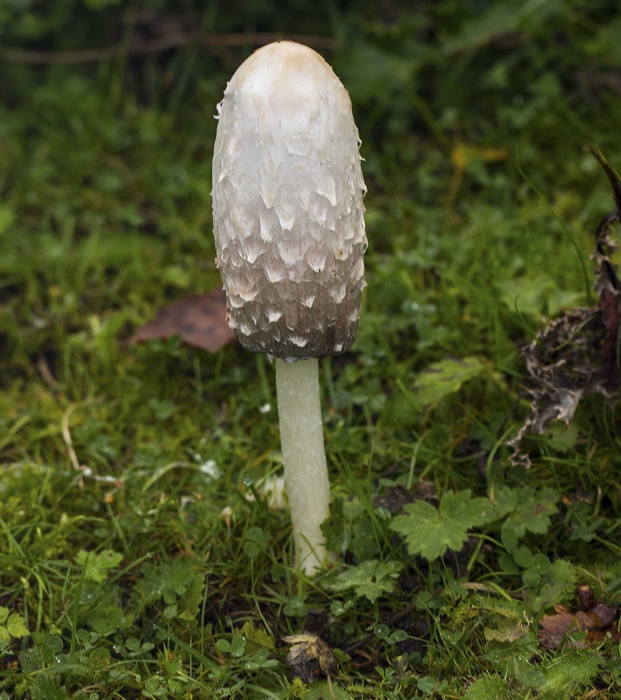
The open hill area we were walking on is not really that good for fungi because of the extensive bracken cover that has been allowed to proliferate – I really dislike this invasive plant and I wish something could be done about it.
However, we were heading for a local Birch copse to look for a particular fungi, the Fly Agaric. This fungi has a very close association with Birch trees and if you ever want to find these lovely fungi look for mature Birch woods.
As we approached a small Birch copse we came across a nice gathering of about ten mushrooms and we thought that was great. I took a few shots and felt quite pleased.
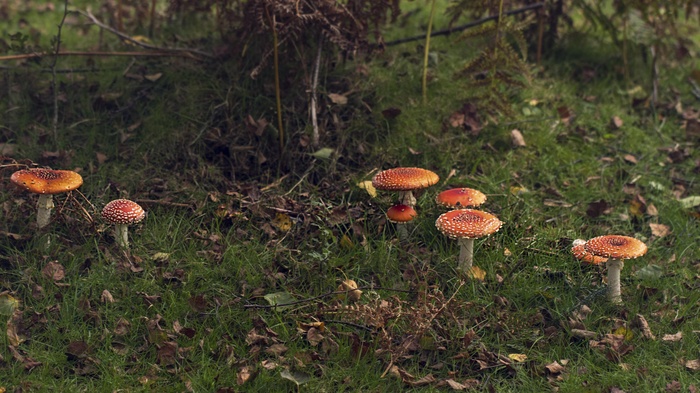
A little further on we approached the main Birch grove and we could see some Ceps or Penny Buns as they are known. I was back down on the floor again to take a shot of these nice mushrooms.
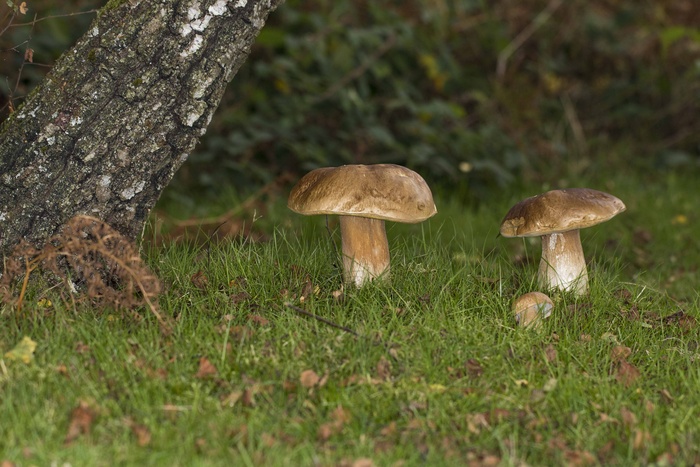
Susan had walked into the grove and suddenly she called me to come in and I could tell by her voice that it was something nice. What played out before me was a true spectacle, a huge gathering of Fly Agaric mushrooms in all stages of growth from small ones just poking through the earth.
To the classic fairy story mushroom shape.
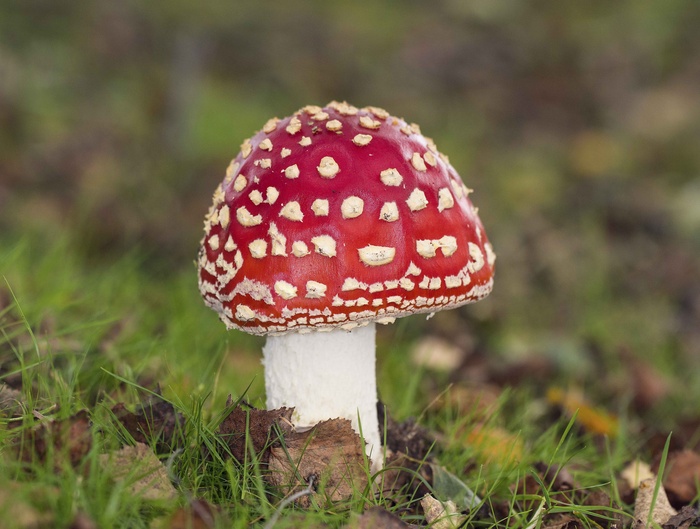
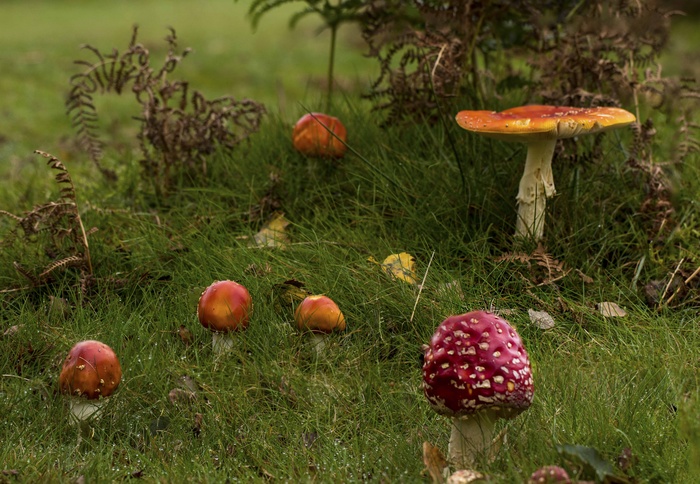
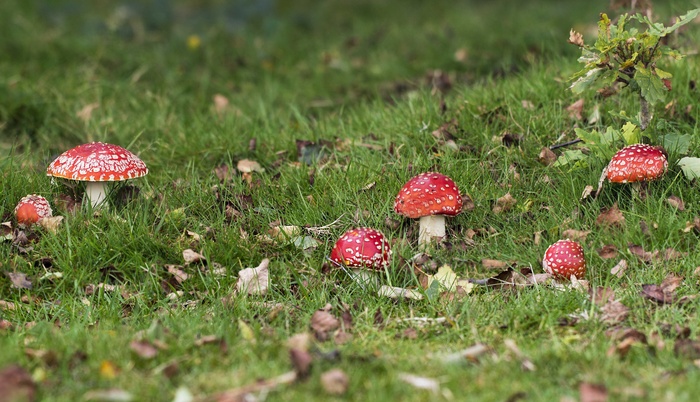
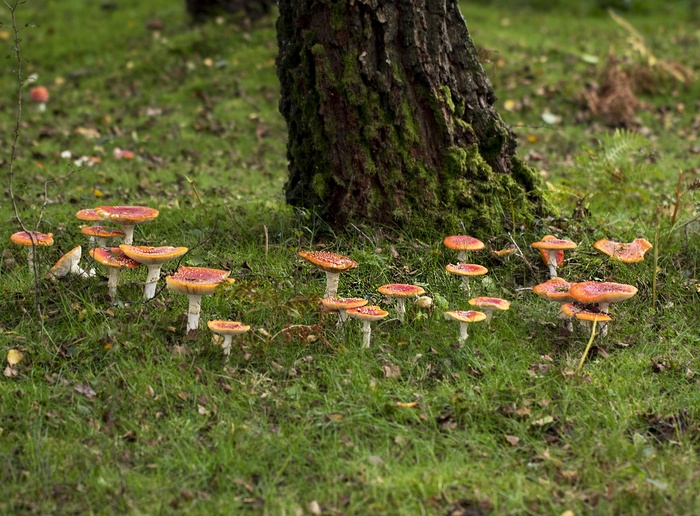
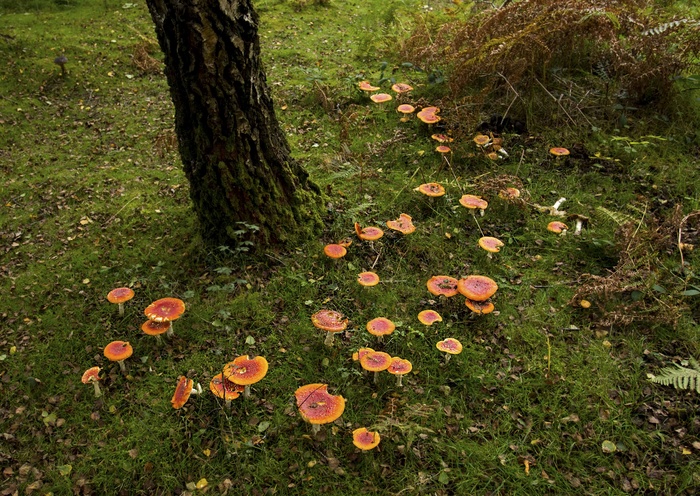
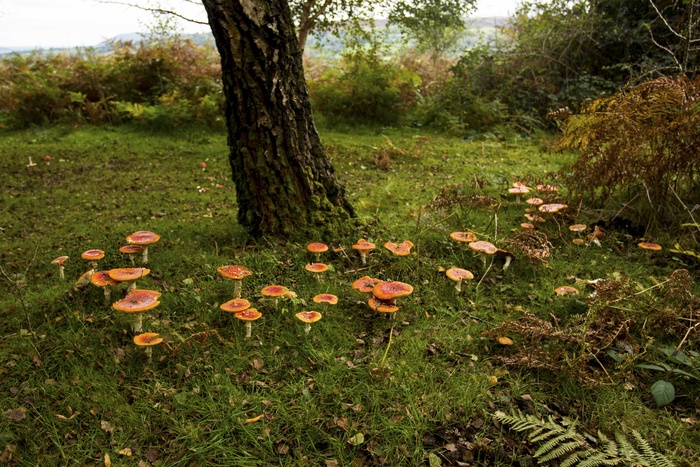
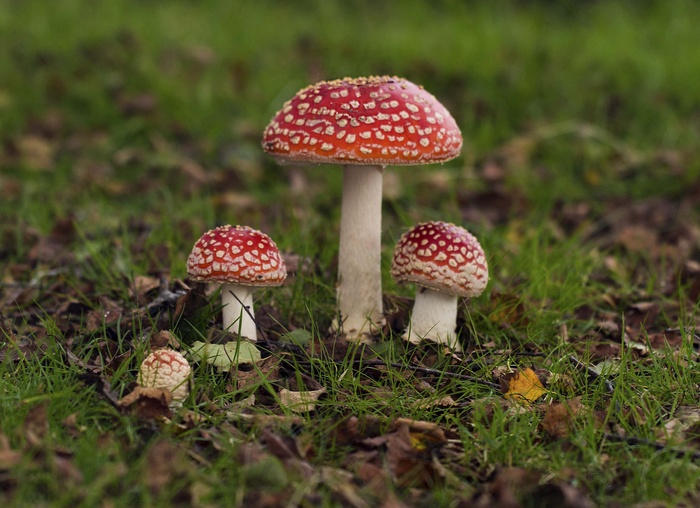
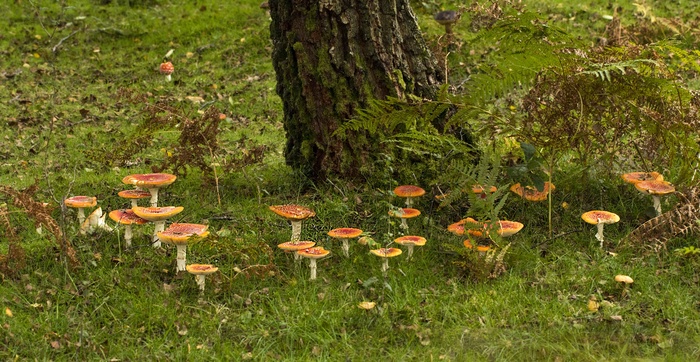
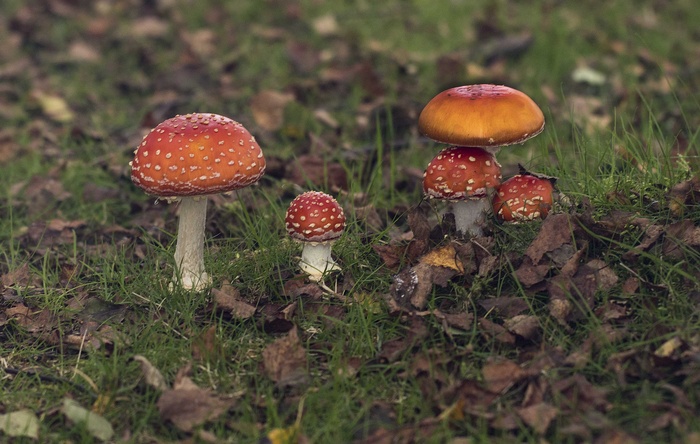
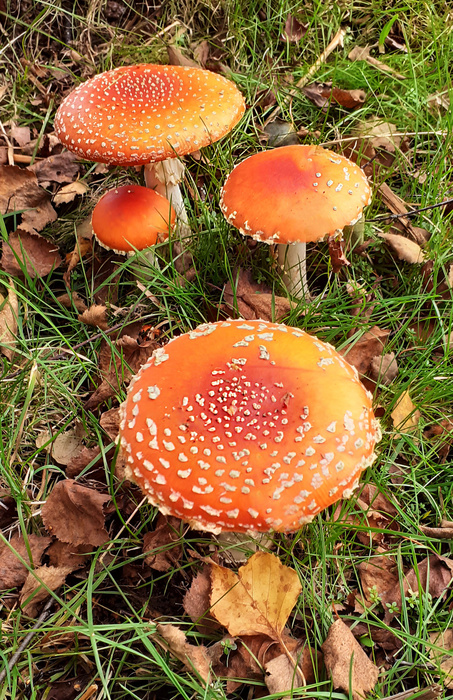
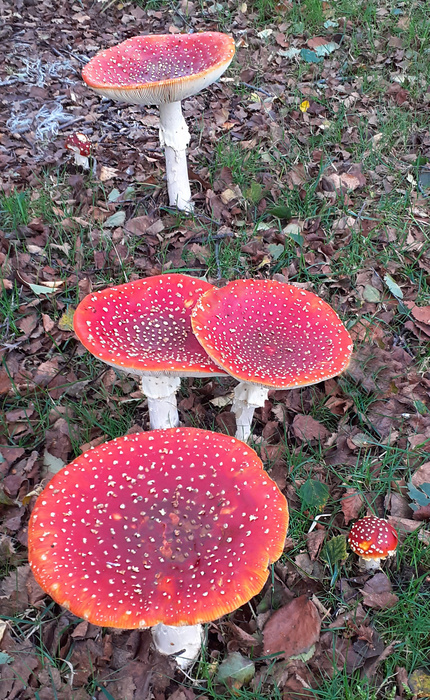
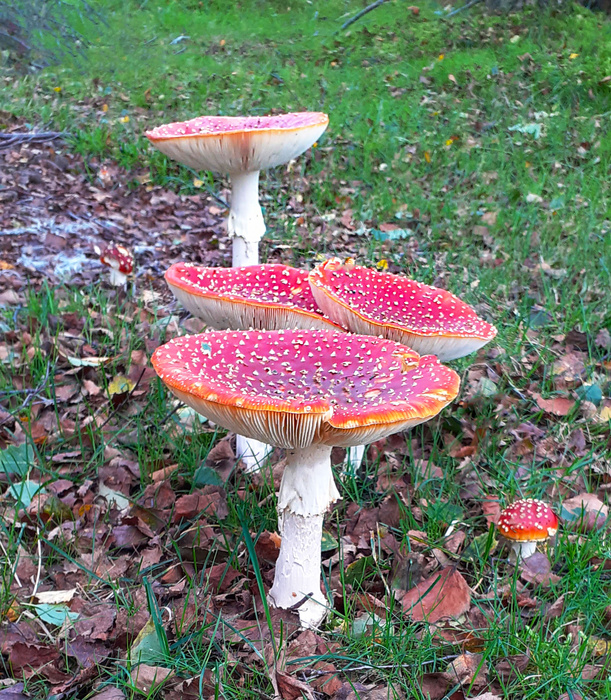
I didn’t know where to start and I took many shots of this lovely scene. This was the best part of the morning, everything else paled by comparison and was well worth getting out for – a lovely surprise.

The open hill area we were walking on is not really that good for fungi because of the extensive bracken cover that has been allowed to proliferate – I really dislike this invasive plant and I wish something could be done about it.
However, we were heading for a local Birch copse to look for a particular fungi, the Fly Agaric. This fungi has a very close association with Birch trees and if you ever want to find these lovely fungi look for mature Birch woods.
As we approached a small Birch copse we came across a nice gathering of about ten mushrooms and we thought that was great. I took a few shots and felt quite pleased.

A little further on we approached the main Birch grove and we could see some Ceps or Penny Buns as they are known. I was back down on the floor again to take a shot of these nice mushrooms.

Susan had walked into the grove and suddenly she called me to come in and I could tell by her voice that it was something nice. What played out before me was a true spectacle, a huge gathering of Fly Agaric mushrooms in all stages of growth from small ones just poking through the earth.
To the classic fairy story mushroom shape.












I didn’t know where to start and I took many shots of this lovely scene. This was the best part of the morning, everything else paled by comparison and was well worth getting out for – a lovely surprise.
Parasols in the Rain.
24th October 2021
24th October 2021
The weather in the Brecon Beacons is very unstable at the moment alternating between quite warm sunshine and vicious rain showers. On Friday of this week, however, the weather forecast predicted a fine day so Susan and I decided to walk up onto a local hillside near to where we live. The day started off bright and sunny as we walked up through an enclosed lane leading to the hill. We were on the lookout for fungi and the Jelly Ear fungus is just starting to appear on the elder trees with a few Sulphur Tufts also along the way, however, as we climbed higher Parasol mushrooms became apparent in some numbers and I stopped to take a few shots of these nice fungi.
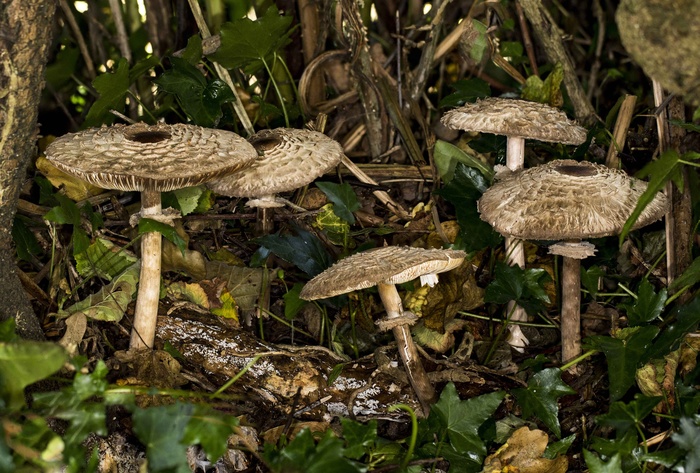
Once we broke out onto the open hill the wind started to get really gusty with a few rain drops in the air. We decided to press on because it didn’t look too much like rain but the wind was now getting quite cold. As we neared the top of the hill quite a spectacle enfolded, a huge amount of much bigger Parasol mushrooms were evident throughout the unimproved grassland. There were literally dozens, some had gone over, others were just coming through, but many were perfect specimens standing a foot high and a foot in diameter – what a sight!
Suddenly on the rocks above we saw something move and although we didn’t have binoculars we could see it was a Northern Wheatear and it stayed quite confiding as we got nearer, it was a late migrating juvenile bird probably brought down in the storm.
We walked on amongst the mushrooms taking many photographs and marvelling at the spectacle.
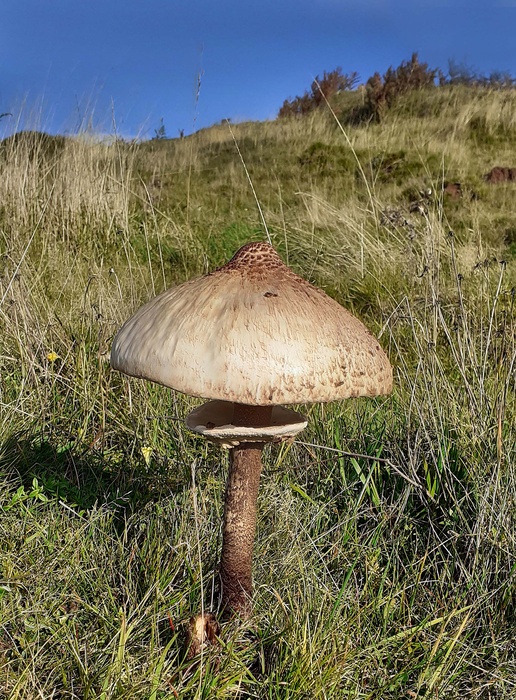
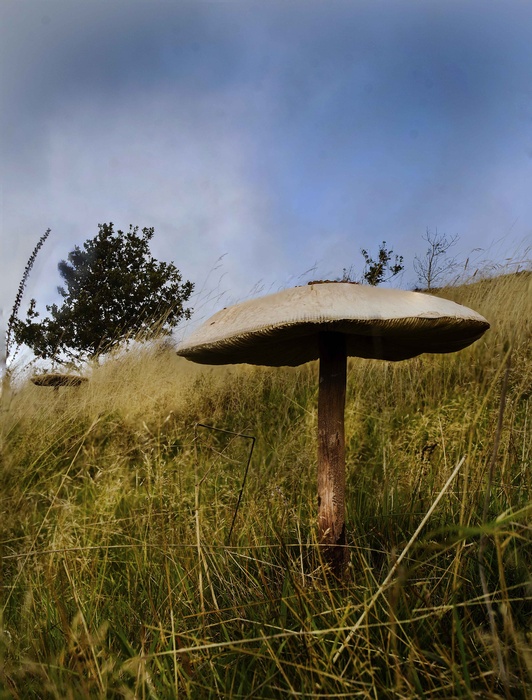
A little further on, however, on a ridge that overlooks the Usk river valley I could see two mature mushrooms in a very photographic situation. I made my way over and set a tripod and lens up to try and take a shot which involved the two mushrooms and the valley in the distance. Typically just as I was about to take a shot a vicious gust of wind toppled one of the mushrooms over but I wasn’t going to let the wind spoil the shot so I re-erected it and packed some earth around the base for support. I’m sure the weather gods didn’t want me to take this shot because before I could set up again a lashing rain shower started so we had to run and take cover behind a stone wall – first the wind and now the rain!
Ten minutes later we returned and thankfully the Parasols were still standing but just as I was about to take the shot again we could see a nice rainbow starting and showing right through my intended shot, so I waited for it to intensify but it started to rain again and we were getting wet but I waited and took the shot.
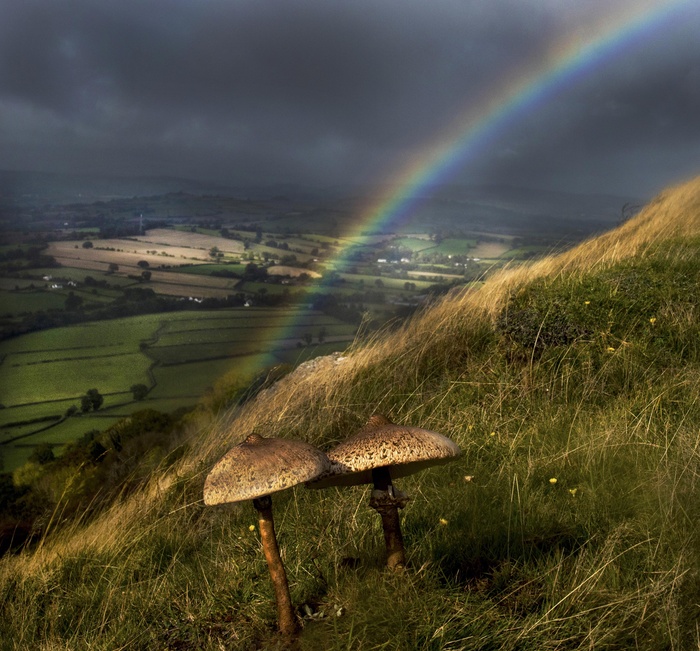
We then ran for cover behind the stone wall again. After the rain abated again we quickly made our way back down to the sanctuary of the tree lined lane. So much for the forecasted fine day, but it was worth it for the Parasol spectacle.

Once we broke out onto the open hill the wind started to get really gusty with a few rain drops in the air. We decided to press on because it didn’t look too much like rain but the wind was now getting quite cold. As we neared the top of the hill quite a spectacle enfolded, a huge amount of much bigger Parasol mushrooms were evident throughout the unimproved grassland. There were literally dozens, some had gone over, others were just coming through, but many were perfect specimens standing a foot high and a foot in diameter – what a sight!
Suddenly on the rocks above we saw something move and although we didn’t have binoculars we could see it was a Northern Wheatear and it stayed quite confiding as we got nearer, it was a late migrating juvenile bird probably brought down in the storm.
We walked on amongst the mushrooms taking many photographs and marvelling at the spectacle.


A little further on, however, on a ridge that overlooks the Usk river valley I could see two mature mushrooms in a very photographic situation. I made my way over and set a tripod and lens up to try and take a shot which involved the two mushrooms and the valley in the distance. Typically just as I was about to take a shot a vicious gust of wind toppled one of the mushrooms over but I wasn’t going to let the wind spoil the shot so I re-erected it and packed some earth around the base for support. I’m sure the weather gods didn’t want me to take this shot because before I could set up again a lashing rain shower started so we had to run and take cover behind a stone wall – first the wind and now the rain!
Ten minutes later we returned and thankfully the Parasols were still standing but just as I was about to take the shot again we could see a nice rainbow starting and showing right through my intended shot, so I waited for it to intensify but it started to rain again and we were getting wet but I waited and took the shot.

We then ran for cover behind the stone wall again. After the rain abated again we quickly made our way back down to the sanctuary of the tree lined lane. So much for the forecasted fine day, but it was worth it for the Parasol spectacle.
Bearded Tits - Don't You Love Them!
08th October 2021
08th October 2021
One morning on our way through Titchwell marsh reserve to have a look at the high tide we passed the reed bed alongside the main track and suddenly a pair of Bearded Tits appeared.
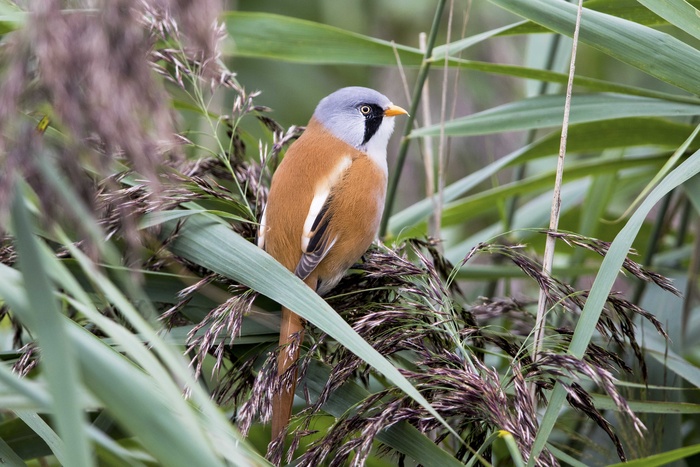
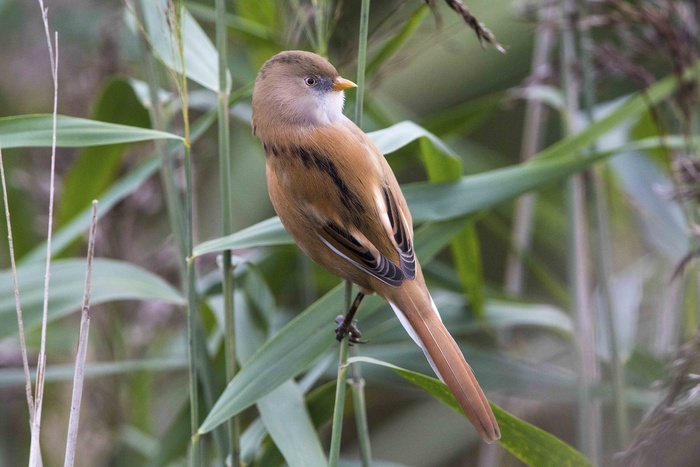
They can do this but they can also stay hidden only giving brief frustrating glimpses as they fly across the reed bed. I have many images of them from over the years but they are always nice to see. I took a quick couple of shots before catching the tide.


They can do this but they can also stay hidden only giving brief frustrating glimpses as they fly across the reed bed. I have many images of them from over the years but they are always nice to see. I took a quick couple of shots before catching the tide.
Holkam Hall - The Quiet Way.
08th October 2021
08th October 2021
Most people who visit the beautiful Holkam Hall in north Norfolk just drive up through the main entrance off the A149 coast road. This is a grand and very attractive setting with lovely flint built houses lining the drive way, impressive gates and a magnificent drive through parkland as you approach the mansion house. However, about a mile further on there is another much smaller entrance on a bad bend just before the town of Wells Next the Sea. We’ve always like this entrance because it is lined with a superb avenue of Holm Oaks.
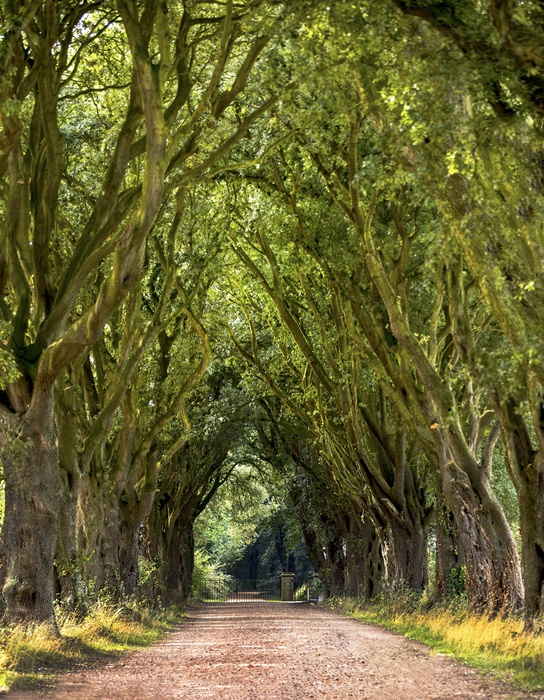
This is a great deal quieter than the main entrance. It is possible to avoid the crowds by entering this way and have a lovely quiet walk through the woods.

This is a great deal quieter than the main entrance. It is possible to avoid the crowds by entering this way and have a lovely quiet walk through the woods.
Willow Emerald Damselfly.
08th October 2021
08th October 2021
The Willow Emerald Damselfly is a very recent colonist to south east England first recorded in the early 2000’s in Suffolk. It is spreading rapidly though and is now also present in Kent, Essex, and Norfolk. It is quite a long damselfly with distinctive features that distinguishes it from the more common Emerald Damselfly. Both male and females have a very long abdomen, pale wing spots with black framing, the males are more overall green.
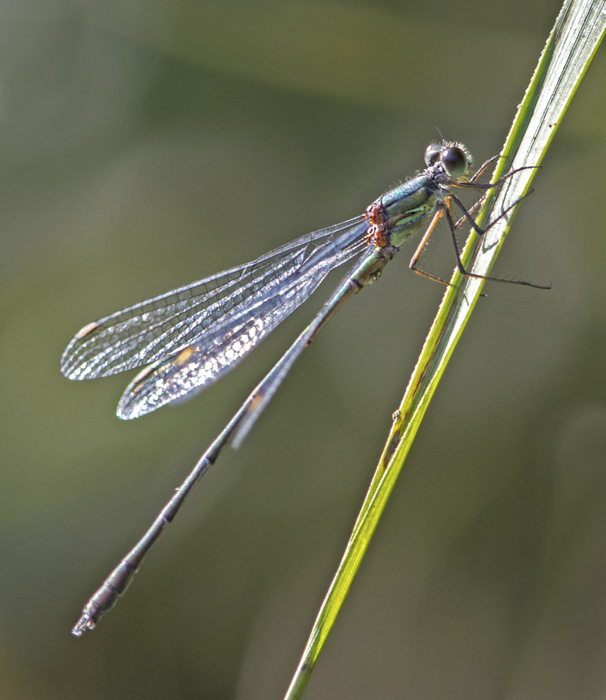
Male.
The females a more bronzy green with a dark ovipositor.
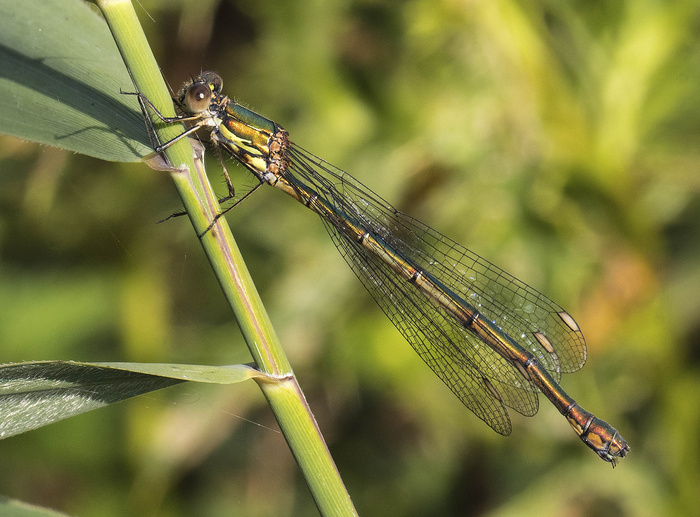
Female.
Unlike other damselflies they spend nearly all of their time in overhanging bushes of willow and alder in which the female lays her eggs.
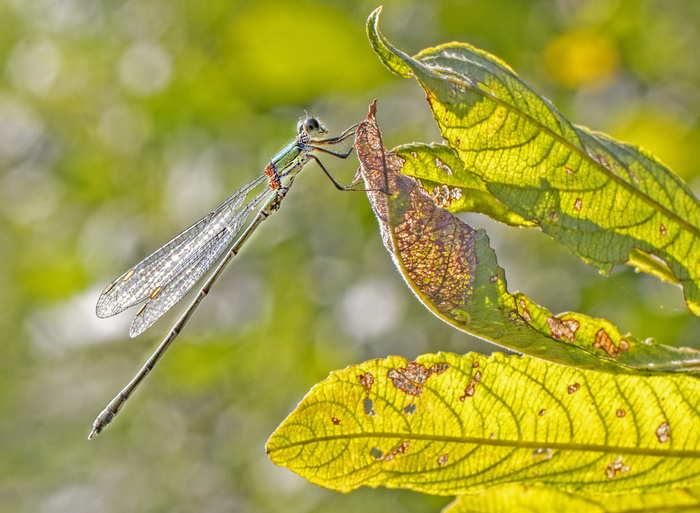
Male.
One morning we spent some time at Sculthorpe Moor nature reserve looking for them with no luck unfortunately, and the reserve was mostly restricted anyway, presumably a legacy of ‘Covid 19 ‘ so it was a waste of time really. Later we decided to try our luck at Titchwell Marsh reserve where we have also seen them briefly a couple of years ago and we were glad we did! In the corner of a boardwalk in some overhanging bushes we found several males and females. However, it’s still not easy to get clear shots of these still relatively small and flimsy insects. After a while jockeying for the best photo opportunity and with Common Darter Dragonflies landing on our hands and heads – good fun! I managed to get a couple of record shots of these lovely damselflies.
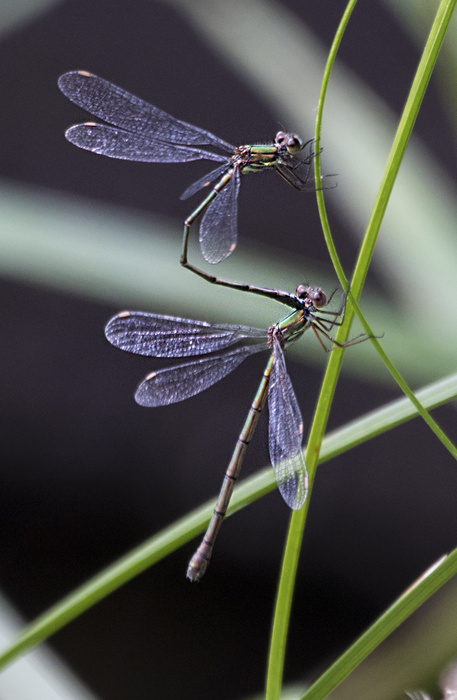
Pair mating.
A very pleasant couple of hours in glorious warm sunshine.

Male.
The females a more bronzy green with a dark ovipositor.

Female.
Unlike other damselflies they spend nearly all of their time in overhanging bushes of willow and alder in which the female lays her eggs.

Male.
One morning we spent some time at Sculthorpe Moor nature reserve looking for them with no luck unfortunately, and the reserve was mostly restricted anyway, presumably a legacy of ‘Covid 19 ‘ so it was a waste of time really. Later we decided to try our luck at Titchwell Marsh reserve where we have also seen them briefly a couple of years ago and we were glad we did! In the corner of a boardwalk in some overhanging bushes we found several males and females. However, it’s still not easy to get clear shots of these still relatively small and flimsy insects. After a while jockeying for the best photo opportunity and with Common Darter Dragonflies landing on our hands and heads – good fun! I managed to get a couple of record shots of these lovely damselflies.

Pair mating.
A very pleasant couple of hours in glorious warm sunshine.
Hunstanton Cliffs and Beach.
08th October 2021
08th October 2021
Although a very popular beach with local people you can still find a little corner to yourself at sunset. It's not too crowded at this time of day because most people like to watch the sunset from up on the road above the cliffs. Hunstanton gets good sunsets because unlike most of north Norfolk it faces west and if you are persistent and wait for the right time it can be absolutely gorgeous. There is a small pool that is always left after the tide ebbs and there are some nice rocks in the middle of it. This little pool gives a partial reflection of the cliffs in the right light.
However, the light on this little pool only lasts for about five minutes, it's when the setting sun is at a particular angle and lights up the cliffs and reflects onto the pool.
It's very fickle and transient in the extreme, so you have to be set up in the right place and be ready because it's there and gone in no time.
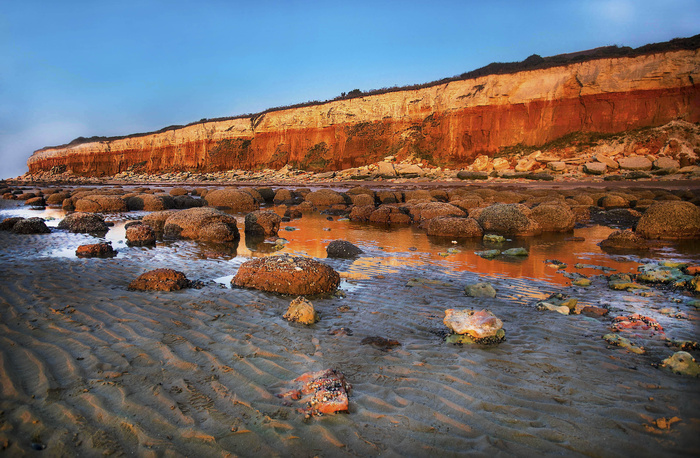
It's definitely worth the effort and is a lovely end to the day.
Canon 5Div
Canon 17-40 f4 lens
Hoya Circular Polarizer
Format Hitech 0.6 graduated filter
However, the light on this little pool only lasts for about five minutes, it's when the setting sun is at a particular angle and lights up the cliffs and reflects onto the pool.
It's very fickle and transient in the extreme, so you have to be set up in the right place and be ready because it's there and gone in no time.

It's definitely worth the effort and is a lovely end to the day.
Canon 5Div
Canon 17-40 f4 lens
Hoya Circular Polarizer
Format Hitech 0.6 graduated filter
North Norfolk - No longer such a special place.
05th October 2021
05th October 2021
Susan and I have just returned from two weeks in north Norfolk, staying in our usual place – Thornham. Thornham has become a very upmarket village over the last ten years with a huge amount of house building, unfortunately mainly second homes for presumably rich city dwellers. The scale of house building in north Norfolk in general is massive with every village you drive through exhibiting new builds. These homes are not social housing for local people, (who have been priced out long ago), these are bespoke million pound affairs. I read recently that the village of Blakeney just down the road from Thornham, a hitherto quaint and quintessential old fishing village, has now over eighty percent second homes – absolutely ridiculous!
We walked around the back of the village one evening, on what is called Thornham green, and we were staggered to see the houses that have been built since our last visit, huge glass fronted properties with balconies overlooking the marshes. I can see why people want to live there because you have easy access to wide open spaces, basically out of your front gate and on to lonely marshes and sea sides - it’s beautiful. As we walked along a marsh track we came across a property that has been erected on six huge wooded poles above a flooded area in the middle of a reed bed elevating it to give lovely views over said reed bed. There were canoes stored underneath on a platform with direct access to the water, ready to paddle away. There was also a private drive laid to provide access to what is obviously a weekend getaway – how the other half live!!
The cars that we see on the A149 north Norfolk coast road show how much money has come into the area - top end Range Rovers, BMW’s, Audi’s, Jaguar and Porsche SUV’s, Aston Martins etc. etc. We went to put fuel in the vehicle in a local garage and there were two brand new Ferraris there filling up. This coast road is not a pleasant drive with horrendous traffic clogging up the coastal villages it passes through. Bearing in mind this was the end of September I can't imagine what it was like during the summer months. Many roads leading to the sea from this road were shut because of traffic volumes, with signs saying 'Car park full'.
One day we passed through the ultimate location for the rich and famous in Norfolk – Burnham Market, nicknamed by locals as ‘Chelsea on Sea’. I have never seen this place so bursting with people, it’s always been nice with good shops and quaint pubs but now it seems that everybody wants to be there, it’s like a magnet for people visiting Norfolk. I wouldn’t shop there now because I refuse to pay these inflated prices.
Visiting Cley Next the Sea, the most famous birding destination around was not a pleasant experience, it has totally changed with no parking anywhere. Droves of people walking around and not one of them a bird watcher, not a pair of binoculars in sight! It is obvious that the birdwatcher is slowly but surely being squeezed out and we don’t like what we are seeing at all. We once thought that we would like to live in north Norfolk, but not any longer - it’s not the place we once knew!
We walked around the back of the village one evening, on what is called Thornham green, and we were staggered to see the houses that have been built since our last visit, huge glass fronted properties with balconies overlooking the marshes. I can see why people want to live there because you have easy access to wide open spaces, basically out of your front gate and on to lonely marshes and sea sides - it’s beautiful. As we walked along a marsh track we came across a property that has been erected on six huge wooded poles above a flooded area in the middle of a reed bed elevating it to give lovely views over said reed bed. There were canoes stored underneath on a platform with direct access to the water, ready to paddle away. There was also a private drive laid to provide access to what is obviously a weekend getaway – how the other half live!!
The cars that we see on the A149 north Norfolk coast road show how much money has come into the area - top end Range Rovers, BMW’s, Audi’s, Jaguar and Porsche SUV’s, Aston Martins etc. etc. We went to put fuel in the vehicle in a local garage and there were two brand new Ferraris there filling up. This coast road is not a pleasant drive with horrendous traffic clogging up the coastal villages it passes through. Bearing in mind this was the end of September I can't imagine what it was like during the summer months. Many roads leading to the sea from this road were shut because of traffic volumes, with signs saying 'Car park full'.
One day we passed through the ultimate location for the rich and famous in Norfolk – Burnham Market, nicknamed by locals as ‘Chelsea on Sea’. I have never seen this place so bursting with people, it’s always been nice with good shops and quaint pubs but now it seems that everybody wants to be there, it’s like a magnet for people visiting Norfolk. I wouldn’t shop there now because I refuse to pay these inflated prices.
Visiting Cley Next the Sea, the most famous birding destination around was not a pleasant experience, it has totally changed with no parking anywhere. Droves of people walking around and not one of them a bird watcher, not a pair of binoculars in sight! It is obvious that the birdwatcher is slowly but surely being squeezed out and we don’t like what we are seeing at all. We once thought that we would like to live in north Norfolk, but not any longer - it’s not the place we once knew!
Excerpts from our garden.
17th September 2021
17th September 2021
With the autumn rapidly approaching ironically the weather has been very pleasant and Susan and I have been sitting out in the garden in the evenings enjoying the late summer sunshine. Just before dusk the local bats start to fly around hunting for insects and a few nice moths have started to appear at this time of day.
Magpie Moth.
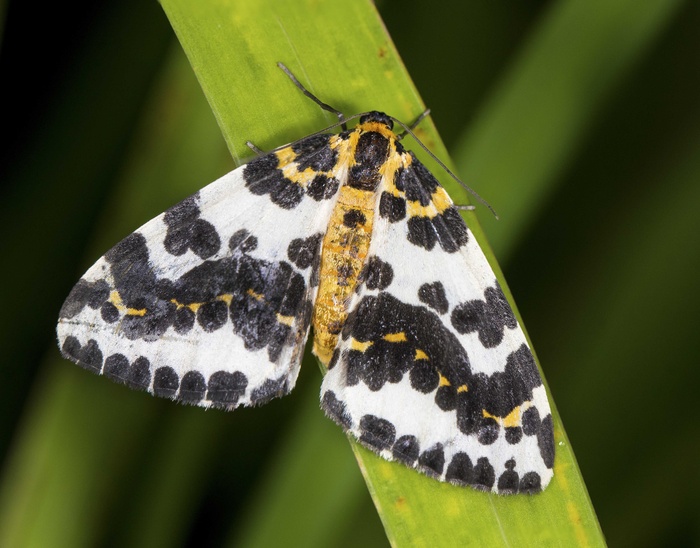
I have cut all the straggly bits off the garden hedges after the local hedge cutter did the main cut with the machine. The hedges won’t grow any more now and the grass is not growing very much either so the garden is in pretty good order ready for the winter. Susan has picked the remaining cooking apples off the trees but the eating apples will need another fortnight before they are ready. We have been feeding any windfalls, apples or pears, to the Red Deer hinds that are in the field adjoining our garden. The trouble is every time I am in the garden they are queuing up waiting for me to feed them and they like the apples so much they are trying to push their heads through the deer fence to get them. When the apples run out they are going to be awfully disappointed!
https://youtu.be/KxQ3z76Ukss
Yesterday evening I caught a Red Underwing moth that was laid up near the roof of our house, I had to get a ladder to reach it but it was easy to get it into a plastic container without any fuss or damage to it. I then put it into a large glass case on our kitchen table and put a cloth over it. It clung to the sides and settled down quite contentedly. I got my macro lens and flash and took two images – one from underneath and one above. Both these images were taken with all the house lights off for effect. These really are a glorious moth with vivid markings.
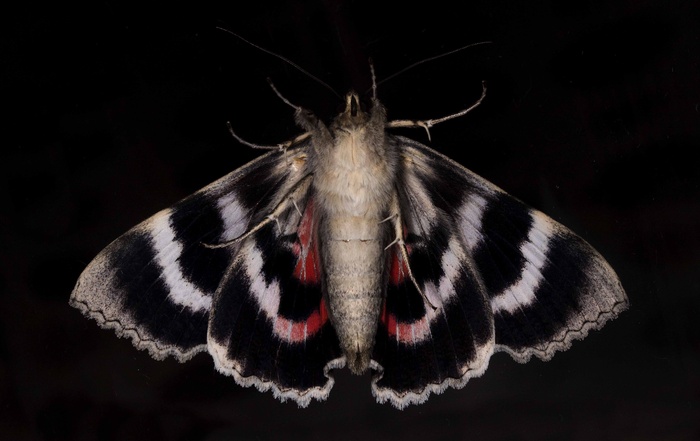
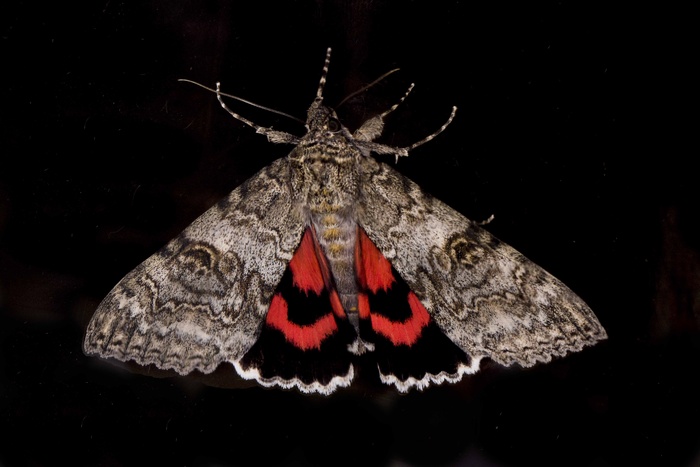
It was then quickly released where it flew strongly into an Ash tree ready for the night to come.
Canon 7D mk2.
Canon ef100 f2.8 is macro lens.
Yongnuo twin macro flash.
Handheld
Magpie Moth.

I have cut all the straggly bits off the garden hedges after the local hedge cutter did the main cut with the machine. The hedges won’t grow any more now and the grass is not growing very much either so the garden is in pretty good order ready for the winter. Susan has picked the remaining cooking apples off the trees but the eating apples will need another fortnight before they are ready. We have been feeding any windfalls, apples or pears, to the Red Deer hinds that are in the field adjoining our garden. The trouble is every time I am in the garden they are queuing up waiting for me to feed them and they like the apples so much they are trying to push their heads through the deer fence to get them. When the apples run out they are going to be awfully disappointed!
https://youtu.be/KxQ3z76Ukss
Yesterday evening I caught a Red Underwing moth that was laid up near the roof of our house, I had to get a ladder to reach it but it was easy to get it into a plastic container without any fuss or damage to it. I then put it into a large glass case on our kitchen table and put a cloth over it. It clung to the sides and settled down quite contentedly. I got my macro lens and flash and took two images – one from underneath and one above. Both these images were taken with all the house lights off for effect. These really are a glorious moth with vivid markings.


It was then quickly released where it flew strongly into an Ash tree ready for the night to come.
Canon 7D mk2.
Canon ef100 f2.8 is macro lens.
Yongnuo twin macro flash.
Handheld
In the woods again.
30th August 2021
30th August 2021
I thought I’d give the local woods one more try for fungi early this morning, there was no sunlight, it was grey skies from the word go, however, it was still a pleasant morning if a little cool. We will have to have some rain before any new fungi really get going so until then I'll wait.
Down under the canopy the light as expected was very subdued with none of the dappled sunlight we had seen over the last few days. As I strolled through the woods even though the light was quite dim something white on the trunk of a tree caught my eye and on closer inspection I could see it was a single Porcelain fungus.
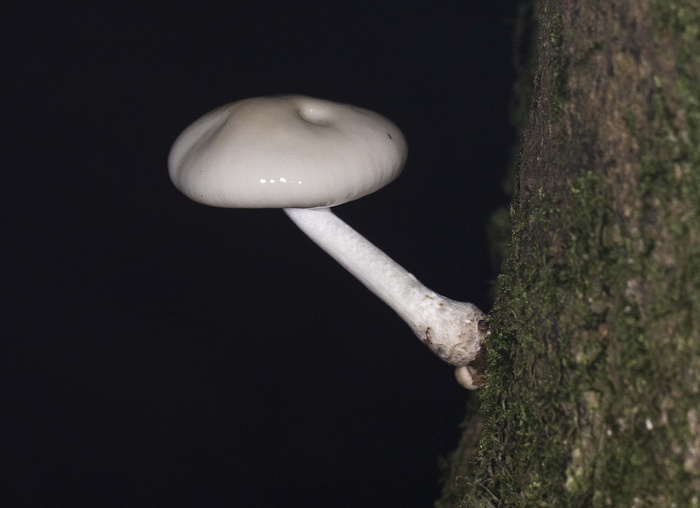
Pure white and glistening just as its name describes. I took a few shots and continued - a good start to the morning I thought.
Scanning the woodland floor there wasn’t much around, the same numerous Blusher fungi as on previous visits.
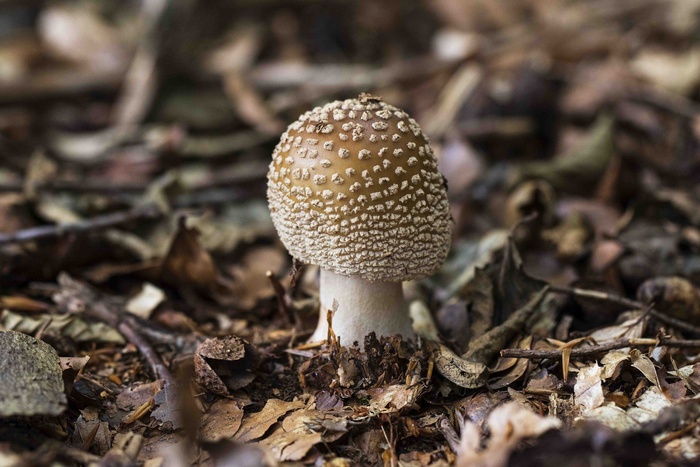
Ironically these days I now find myself looking down instead of previously looking up - for birds, how things change – that will alter when a bit of migrations starts I’m sure. I could, however, hear the call of a male Bullfinch in the distance and a party of Long Tailed Tits passed overhead calling noisily.
Further on I came across some small red fungi and I could see they were Sickners.
Very nice vivid little mushrooms and they were accompanied by a gathering of Pixie Cup fungi – nice to see together.
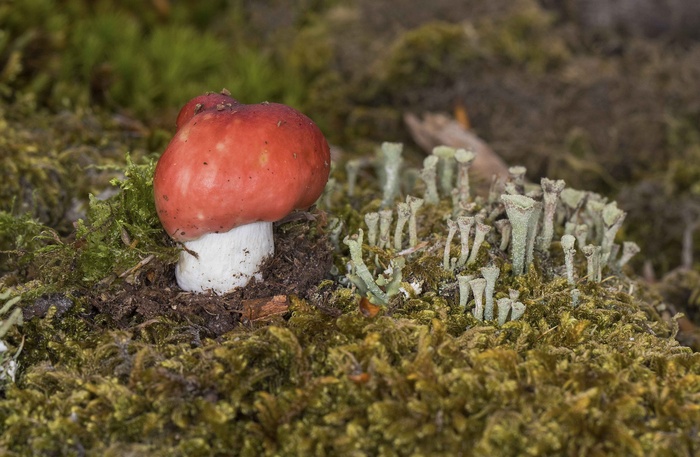
I was coming to the really dark part of the woods now and wasn’t expecting much in the gloom, but to my surprise on an old tree stump I could see a beautiful array of Sulphur Tuft mushrooms, these are quite poisonous to eat and should be left alone but still made a lovely photogenic scene. I laid out my weed suppressant and kneeling mat, (previous blog), and set up my little LED light on the mini tripod. This little LED really lifted the scene and I can’t recommend these lights highly enough and along with my Yongnuo twin macro flash I took a few shots of this delightful scene.
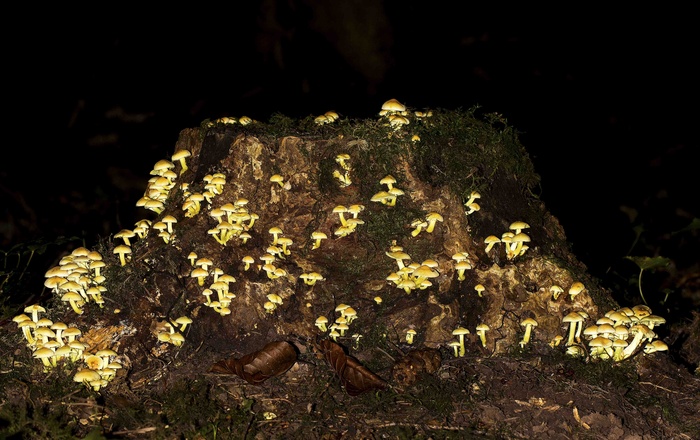
In these woods, in what was real gloom, without extra light it would not have been possible to get any sort of shot. It turned out to be a quite productive morning after all, grey clouds or not.
Down under the canopy the light as expected was very subdued with none of the dappled sunlight we had seen over the last few days. As I strolled through the woods even though the light was quite dim something white on the trunk of a tree caught my eye and on closer inspection I could see it was a single Porcelain fungus.

Pure white and glistening just as its name describes. I took a few shots and continued - a good start to the morning I thought.
Scanning the woodland floor there wasn’t much around, the same numerous Blusher fungi as on previous visits.

Ironically these days I now find myself looking down instead of previously looking up - for birds, how things change – that will alter when a bit of migrations starts I’m sure. I could, however, hear the call of a male Bullfinch in the distance and a party of Long Tailed Tits passed overhead calling noisily.
Further on I came across some small red fungi and I could see they were Sickners.
Very nice vivid little mushrooms and they were accompanied by a gathering of Pixie Cup fungi – nice to see together.

I was coming to the really dark part of the woods now and wasn’t expecting much in the gloom, but to my surprise on an old tree stump I could see a beautiful array of Sulphur Tuft mushrooms, these are quite poisonous to eat and should be left alone but still made a lovely photogenic scene. I laid out my weed suppressant and kneeling mat, (previous blog), and set up my little LED light on the mini tripod. This little LED really lifted the scene and I can’t recommend these lights highly enough and along with my Yongnuo twin macro flash I took a few shots of this delightful scene.

In these woods, in what was real gloom, without extra light it would not have been possible to get any sort of shot. It turned out to be a quite productive morning after all, grey clouds or not.
Fungi photography in the woods.
28th August 2021
28th August 2021
Susan and I were out walking in a mixed woodland this week looking in particular for fungi because the birding in the Brecon Beacons is pretty flat at the moment and the Odonata have stalled in the cool weather we have been experiencing. We have developed more than a passing interest in this fascinating subject and I can only see it growing even more in the future. I only wish we had started earlier because the photographic opportunities are many and varied. The only trouble is you have to get flat on the ground for most of the shots. In order to do this I carry a large sheet of weed suppressant to lie on and a garden kneeling pad for comfort, people may laugh but getting decent images involves getting into the most contorted positions and I have had some funny looks from people passing by. My macro lens is getting far more use than any other lens during this time and it is getting some decent results. I am using my Yongnuo twin macro flash unit with this lens and a little LED light on a mini flexible ‘Gorilla’ type tripod for extra light, (see review on the Yongnuo flash in the equipment reviews section on the front page of this site). – Well worth the money! We have seen a good variety of fungi this week and the main season hasn’t started yet so many more to find we hope.
Below are a few of the many we have found.
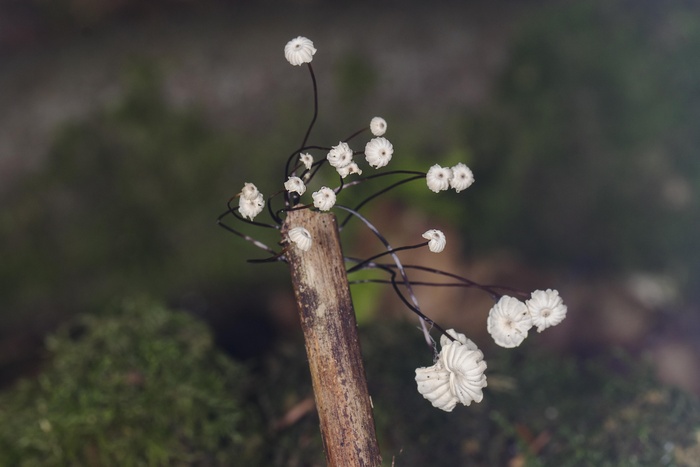
Collared Parachute Fungi - pretty and delicate growing on wood in leaf litter.
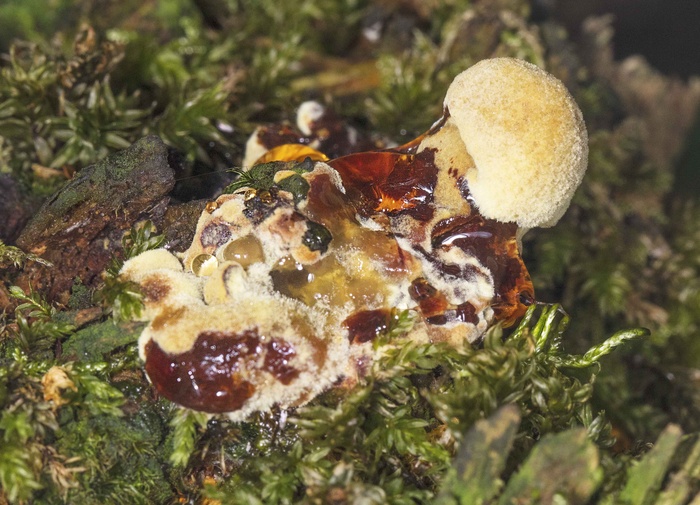
Alder Bracket Fungus - very unusual looking, like some exotic dessert.
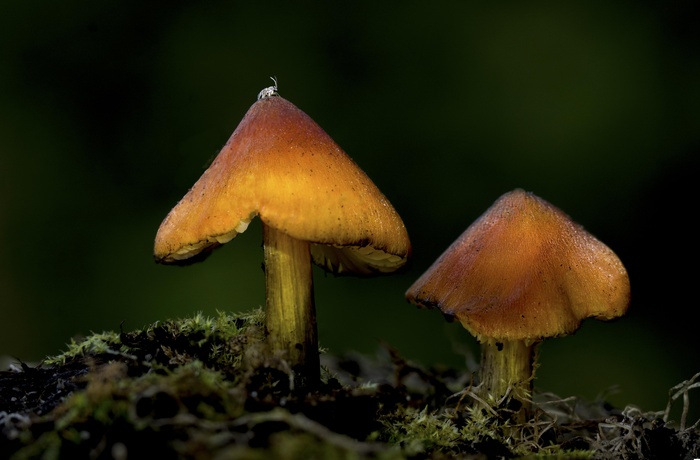
Witches Hat fungi - as I was taking this shot a tiny insect landed on one of the mushrooms, it was only about two millimetres in length - remarkable!
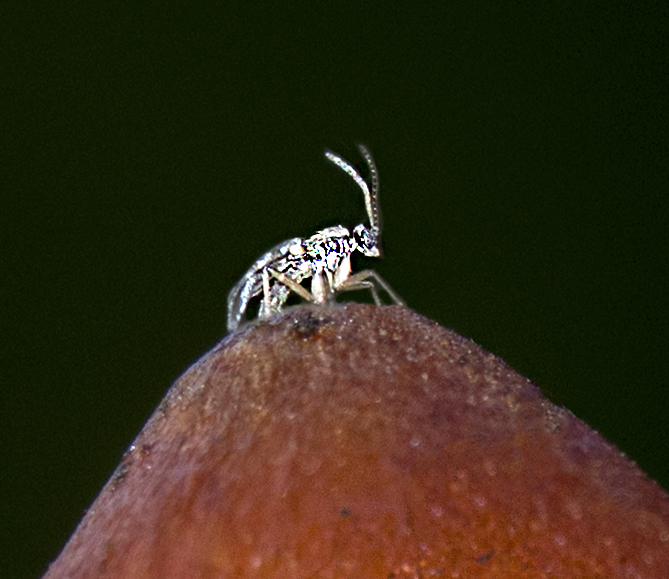
Here it is blown up - I've no idea what it is.
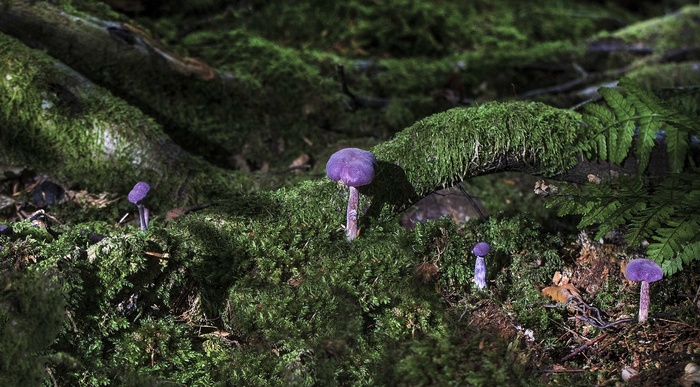
Amethyst deceivers found in what looked like a fairies glen - lovely setting to find.
Below are a few of the many we have found.

Collared Parachute Fungi - pretty and delicate growing on wood in leaf litter.

Alder Bracket Fungus - very unusual looking, like some exotic dessert.

Witches Hat fungi - as I was taking this shot a tiny insect landed on one of the mushrooms, it was only about two millimetres in length - remarkable!

Here it is blown up - I've no idea what it is.

Amethyst deceivers found in what looked like a fairies glen - lovely setting to find.
Mountain Stream Again.
27th July 2021
27th July 2021
Thankfully the weather has become more bearable over the last few days with those sultry conditions, especially at night, disappearing. After a previously pleasant morning, photographically speaking, I found myself back at the little moorland stream, (previous blog), which more accurately should now be described as a trickle. Nevertheless, the ‘Dragons and Damsels’ don’t mind these conditions because they are out in numbers, mating and then ovipositing their eggs continuously - time is short for these aerial beauties.
It is also now easier for me to sit on my ‘walkstool’ in the water wearing wellingtons, and wait for one of them to perch on nearby vegetation. Over the last few days the Black Darter dragonfly has emerged, this is one of my favourites, they are so small and delicate and are easily missed amongst the vegetation. They prefer the reeds and long grass to open water so that’s the best place to try and photograph them, because once located they like to return to the same perch time and time again. All a photographer has to do is be patient and keep a reasonable distance to obtain some shots. I waited for some time until I saw a male flying around some reeds and true to form he was perching continually on the same couple of reed stems.
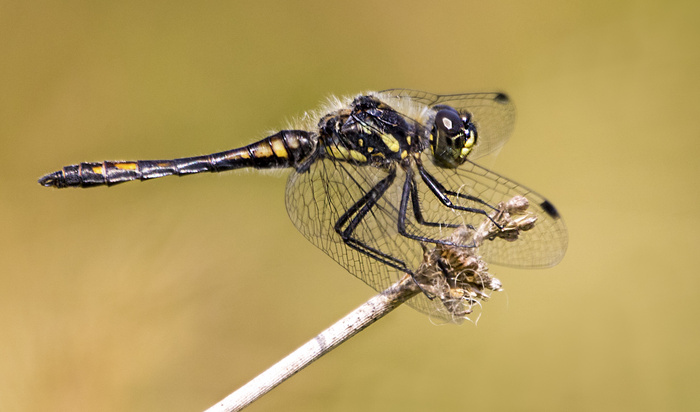
I had to use my Sigma 150-600mm C lens on my Canon 7D ii to get some shots because these dragonflies won’t tolerate close approach with a macro lens. This lens will only focus down to 2.8 metres but with a 25mm extension tube that MFD is reduced by a couple of feet. I set up by sitting on my stool with the lens on a tripod and just waited for him to return. These really are a lovely little creature with a burnt black appearance interspersed with orange markings.
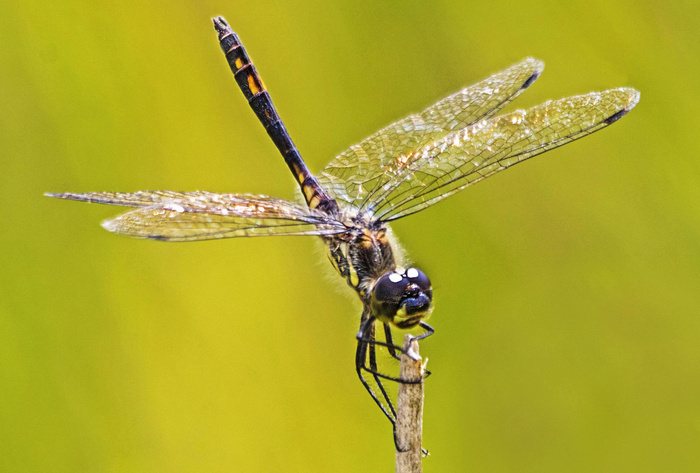
Once I had taken some decent shots I moved to another part of the stream where it flows under a road through a large diameter pipe. This pipe is obviously dark inside and provides a very contrasting background with the bright sunlight outside. I picked a reasonably strong reed stem and propped it up in the stream bed using some small stones right in front of the pipe entrance so if anything perched on this reed then there would make a nice black background. You have to make these perches attractive to your potential subjects or they will just ignore them, (just like Kingfishers e.g.). Sometimes it takes a few attempts because wildlife can and often is very fickle! I again sat on my stool with the Sigma and the 7D ii on a tripod and waited but there was nothing doing. I looked at the other naturally growing reeds nearby and realised that they were all bent over at an angle and my artificially propped reed was almost vertical so I arranged it at roughly the same angle as the others and within a minute a Keeled Skimmer was perched right on it.
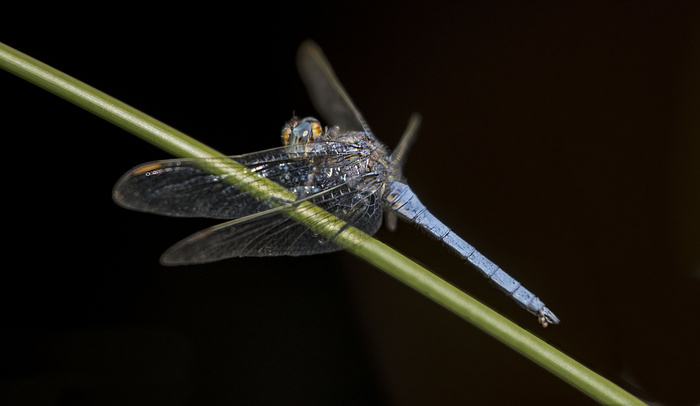
It was just at too steep an angle and therefore awkward for them to perch on! I again had some reasonable shots before there was some argy-bargy between the Keeled Skimmer and a Common Darter – the darter must also have fancied the perch. The darter triumphed and I wasn’t complaining because I had some more shots!
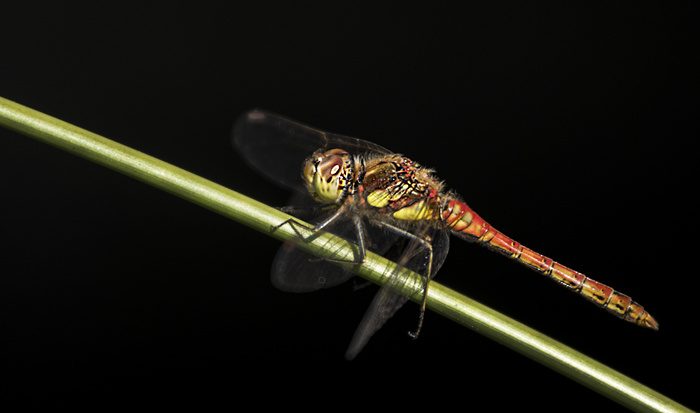
However, the Keeled Skimmer had now perched right by the side of me clinging to a tall reed, I reached over quietly for my Macro lens which I had on my Canon 5D iv and just kept leaning closer and closer until I was about six inches away and incredibly it didn’t move.
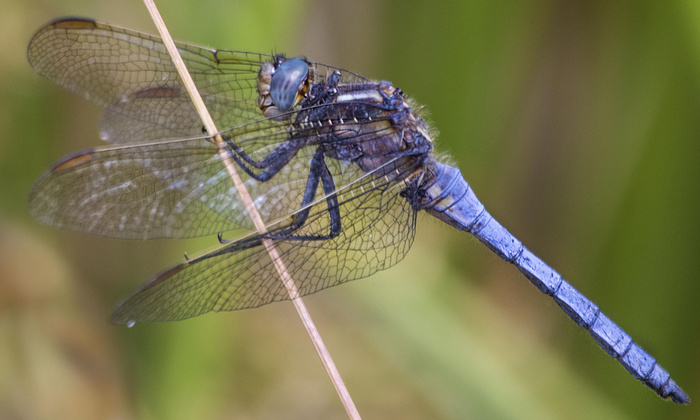
I find that as long as your movements are quiet and very gradual you can get quite close to some of these dragonflies.
It was quite an enjoyable session and I can happily spend a couple of hours at this location with nobody around but the wildlife.
Later in the day Susan came in to the house to say there was a Southern Hawker ovipositing in one of our garden ponds, a first for the garden.
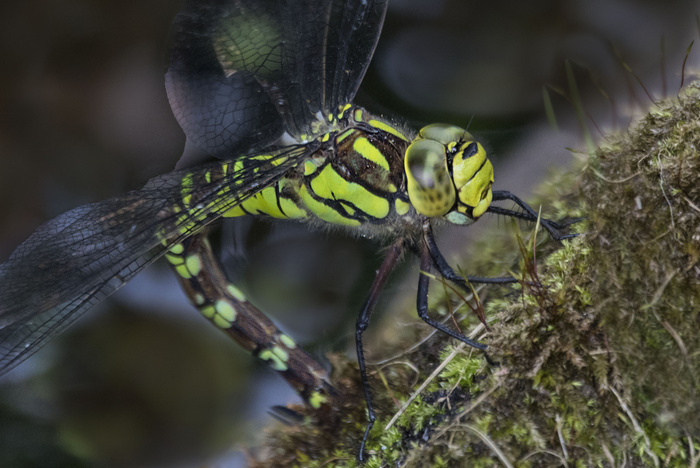
However, she didn’t stay long and I could only grab a quick shot before she disappeared up and over the trees and into the dimming evening light – a very nice end to the day.
It is also now easier for me to sit on my ‘walkstool’ in the water wearing wellingtons, and wait for one of them to perch on nearby vegetation. Over the last few days the Black Darter dragonfly has emerged, this is one of my favourites, they are so small and delicate and are easily missed amongst the vegetation. They prefer the reeds and long grass to open water so that’s the best place to try and photograph them, because once located they like to return to the same perch time and time again. All a photographer has to do is be patient and keep a reasonable distance to obtain some shots. I waited for some time until I saw a male flying around some reeds and true to form he was perching continually on the same couple of reed stems.

I had to use my Sigma 150-600mm C lens on my Canon 7D ii to get some shots because these dragonflies won’t tolerate close approach with a macro lens. This lens will only focus down to 2.8 metres but with a 25mm extension tube that MFD is reduced by a couple of feet. I set up by sitting on my stool with the lens on a tripod and just waited for him to return. These really are a lovely little creature with a burnt black appearance interspersed with orange markings.

Once I had taken some decent shots I moved to another part of the stream where it flows under a road through a large diameter pipe. This pipe is obviously dark inside and provides a very contrasting background with the bright sunlight outside. I picked a reasonably strong reed stem and propped it up in the stream bed using some small stones right in front of the pipe entrance so if anything perched on this reed then there would make a nice black background. You have to make these perches attractive to your potential subjects or they will just ignore them, (just like Kingfishers e.g.). Sometimes it takes a few attempts because wildlife can and often is very fickle! I again sat on my stool with the Sigma and the 7D ii on a tripod and waited but there was nothing doing. I looked at the other naturally growing reeds nearby and realised that they were all bent over at an angle and my artificially propped reed was almost vertical so I arranged it at roughly the same angle as the others and within a minute a Keeled Skimmer was perched right on it.

It was just at too steep an angle and therefore awkward for them to perch on! I again had some reasonable shots before there was some argy-bargy between the Keeled Skimmer and a Common Darter – the darter must also have fancied the perch. The darter triumphed and I wasn’t complaining because I had some more shots!

However, the Keeled Skimmer had now perched right by the side of me clinging to a tall reed, I reached over quietly for my Macro lens which I had on my Canon 5D iv and just kept leaning closer and closer until I was about six inches away and incredibly it didn’t move.

I find that as long as your movements are quiet and very gradual you can get quite close to some of these dragonflies.
It was quite an enjoyable session and I can happily spend a couple of hours at this location with nobody around but the wildlife.
Later in the day Susan came in to the house to say there was a Southern Hawker ovipositing in one of our garden ponds, a first for the garden.

However, she didn’t stay long and I could only grab a quick shot before she disappeared up and over the trees and into the dimming evening light – a very nice end to the day.
Photography in the Heat.
18th July 2021
18th July 2021
At last some meaningful emergence of the local Odonata. This warm weather is bringing them out in numbers, albeit about three weeks to a month behind last year for some species. On a local upland stream Golden Ringed dragonflies are now flying and also some Emperors are on the wing. On Friday in the heat there was a big emergence of Keeled Skimmers and Four Spotted Chasers. There are thousands of damselflies milling around, with Common Blue, Blue Tail, Scarce Blue Tail, Azure and Large Red in numbers. Beautiful Demoiselles are also flying in small numbers - living up to their name.
I was sat on my walk stool on the edge of the above mentioned small stream watching Large Red Damselflies going about their business. I was wearing shorts and with the cooling water running over my wellington clad feet I felt very contented. However, the sun was still fierce and unrelenting in a cloudless sky and I was really feeling it through my wide brimmed hat. A woman walker passed by about fifty yards away and stopped to look at me, seemingly amused by this strange man sat on a stool in a stream wearing shorts and wellingtons - nevertheless I was prepared to wager my feet were cooler than hers!
As I looked at a few stems of Rye grass on the stream’s edge I could see a male and female Large Red Damselfly mating. The grass stem was in isolation with no ‘clutter’ just a mellow pastel coloured background. People who read this blog know I like a smooth background, it’s just as important as the subject for me. I was using a 100mm macro lens with an extension tube on my Canon 7D2 and handholding this kit allowed me to get in quite close - if the insects allowed! Fortunately for me they were ‘preoccupied’ and I got to within a few inches of them, and when the grass stem stopped swaying in the very slight stream-side breeze I fired off a few shots. I backed off then and checked the images on the camera and they looked Ok.
Notice the classic inverted heart shape mating posture which is typical of this order of insects.
The male clasps the female behind her head and she then lifts her abdomen up so that the end segment which contains her unfertilized eggs comes into contact with the males reproductive gland and her eggs are then fertilized. She then later uses her ovipositor to lay the eggs back into typically a stream or pond, thereby starting the whole life cycle over again.
(The only sad thing is when we see these beautiful creatures flying around enriching our lives they are at the very end of their life and will die soon after. These little wisps of transient beauty last for as little as a couple of weeks).
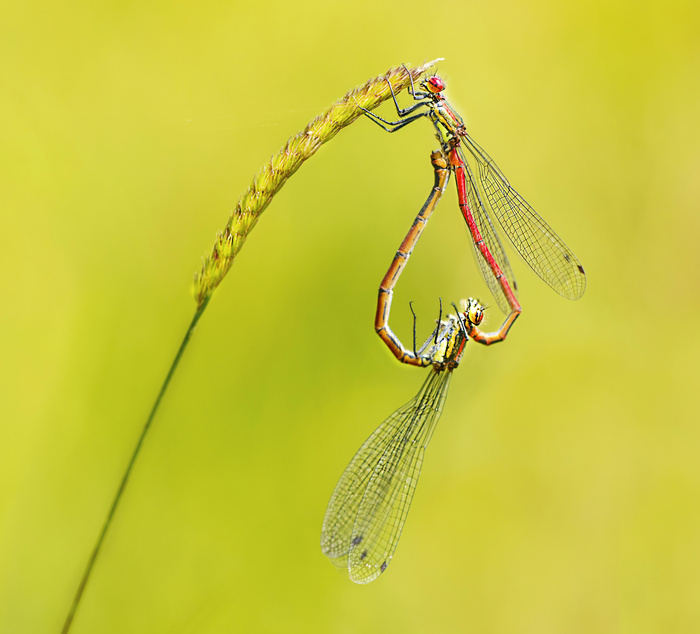
Canon 7D MK2 DSLR
Canon 100mm f2.8 Macro Lens
Canon 25mm Extension Tube
Handheld manual focus
I decided to pack in then because it was now late afternoon and the heat was becoming debilitating. When I got home and after a cool shower I still felt overheated so I forced myself to drink some cans of ice cold cider in the shade in my garden – it’s tough I know but somebodies got to do it!
I was sat on my walk stool on the edge of the above mentioned small stream watching Large Red Damselflies going about their business. I was wearing shorts and with the cooling water running over my wellington clad feet I felt very contented. However, the sun was still fierce and unrelenting in a cloudless sky and I was really feeling it through my wide brimmed hat. A woman walker passed by about fifty yards away and stopped to look at me, seemingly amused by this strange man sat on a stool in a stream wearing shorts and wellingtons - nevertheless I was prepared to wager my feet were cooler than hers!
As I looked at a few stems of Rye grass on the stream’s edge I could see a male and female Large Red Damselfly mating. The grass stem was in isolation with no ‘clutter’ just a mellow pastel coloured background. People who read this blog know I like a smooth background, it’s just as important as the subject for me. I was using a 100mm macro lens with an extension tube on my Canon 7D2 and handholding this kit allowed me to get in quite close - if the insects allowed! Fortunately for me they were ‘preoccupied’ and I got to within a few inches of them, and when the grass stem stopped swaying in the very slight stream-side breeze I fired off a few shots. I backed off then and checked the images on the camera and they looked Ok.
Notice the classic inverted heart shape mating posture which is typical of this order of insects.
The male clasps the female behind her head and she then lifts her abdomen up so that the end segment which contains her unfertilized eggs comes into contact with the males reproductive gland and her eggs are then fertilized. She then later uses her ovipositor to lay the eggs back into typically a stream or pond, thereby starting the whole life cycle over again.
(The only sad thing is when we see these beautiful creatures flying around enriching our lives they are at the very end of their life and will die soon after. These little wisps of transient beauty last for as little as a couple of weeks).

Canon 7D MK2 DSLR
Canon 100mm f2.8 Macro Lens
Canon 25mm Extension Tube
Handheld manual focus
I decided to pack in then because it was now late afternoon and the heat was becoming debilitating. When I got home and after a cool shower I still felt overheated so I forced myself to drink some cans of ice cold cider in the shade in my garden – it’s tough I know but somebodies got to do it!
Local Wildflower Meadows.
11th July 2021
11th July 2021
At last we are having the odd warm spell of weather and this has encouraged the wild flowers in the meadows that border Llangors Lake to flourish. There are large numbers of Orchids, (Common Spotted), in these meadows along with a huge growth of Meadow Buttercups.
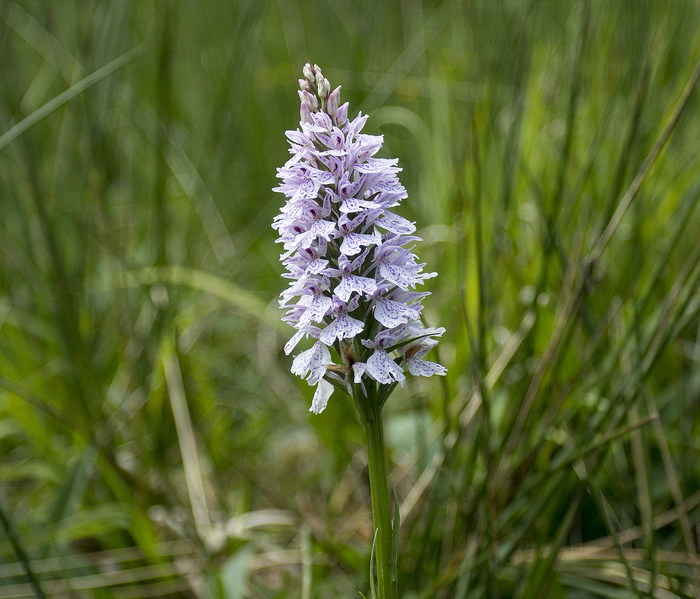
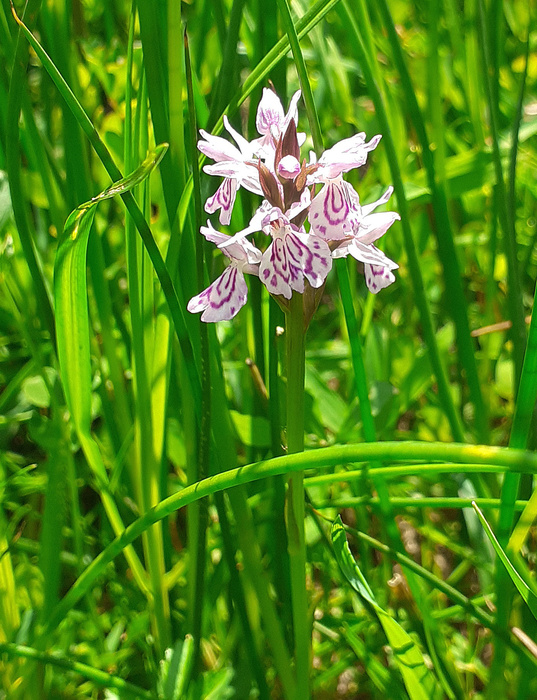
It’s been a marvellous year for Buttercups), and everywhere seems to be yellow with these lovely flowers. However, in one particular location where Globe Flowers (a member of the Buttercup family) grow annually.
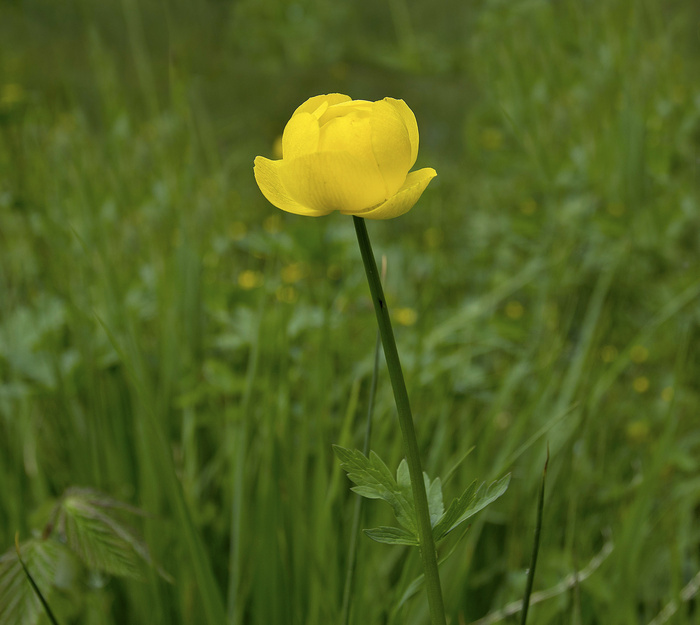
There is a disappointing display – Odd!
In the Llangasty meadows there are also Greater Knapweed, and just one or two examples of Ragged Robin.
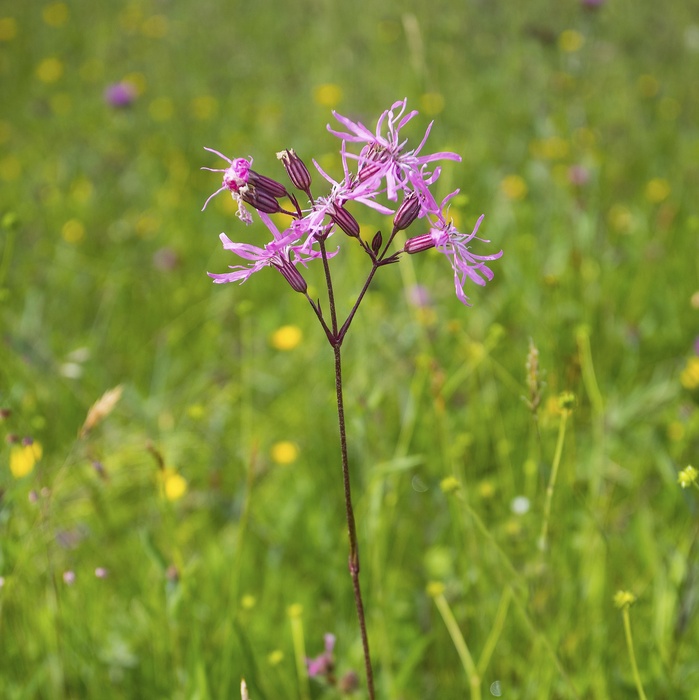
A particular favourite of mine – I just like the name!
I wondered along these meadows early in the morning this week just after sunrise with my landscape lens and took a frame or two because these lovely meadow scenes are few and far between in this area. I got down low because I wanted to frame a tree which is at the top of the meadow on the horizon which I thought added to the scene.
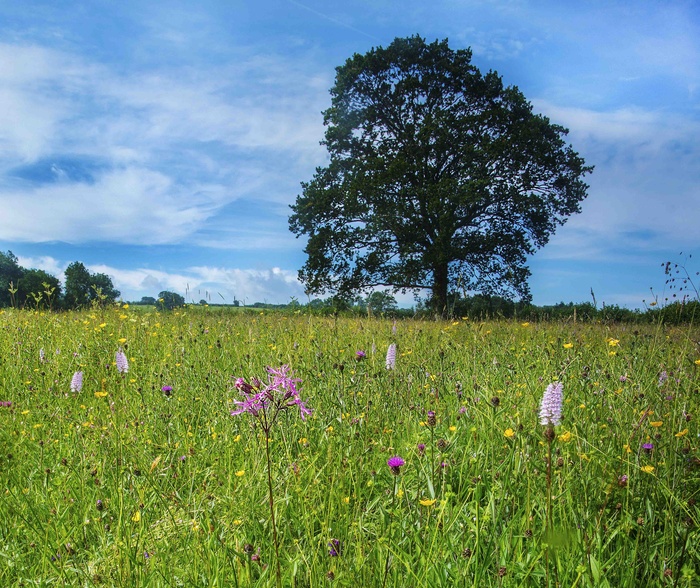
However, in doing this I did get a few insect bites, but that’s all part of the fun!
I have also seen a few other Orchids around during these past weeks.
Southern Marsh Orchid.
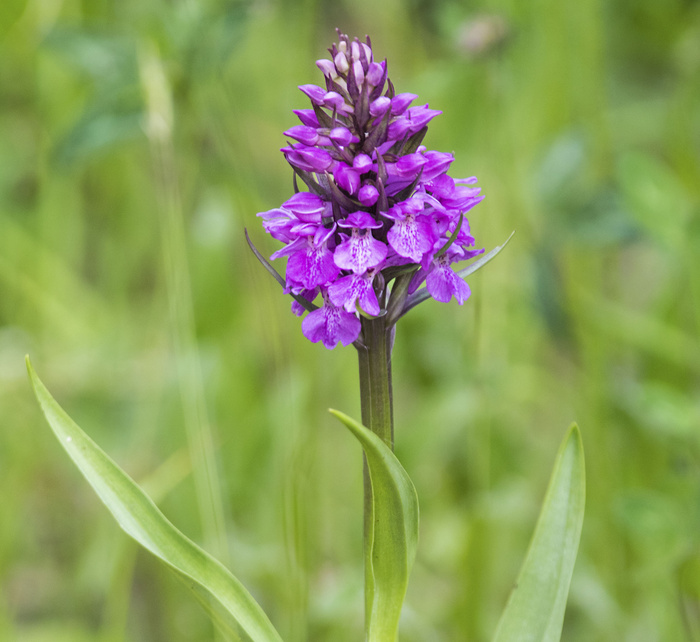
Bee Orchid.
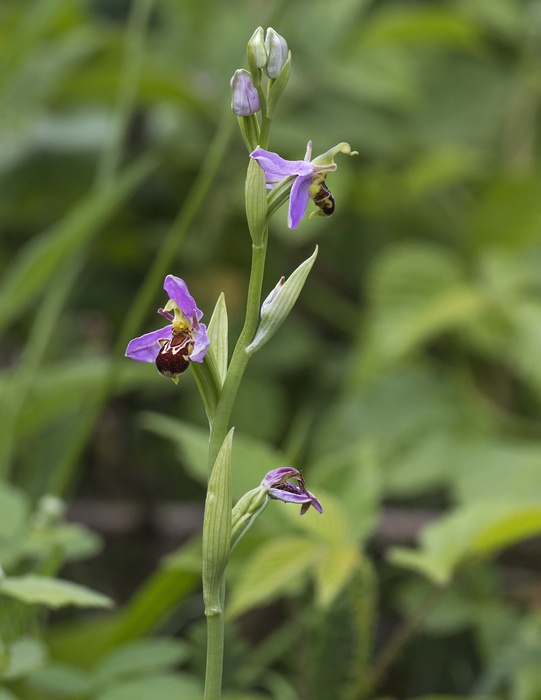
Common Spotted Orchids competing with Bracken for light and space.
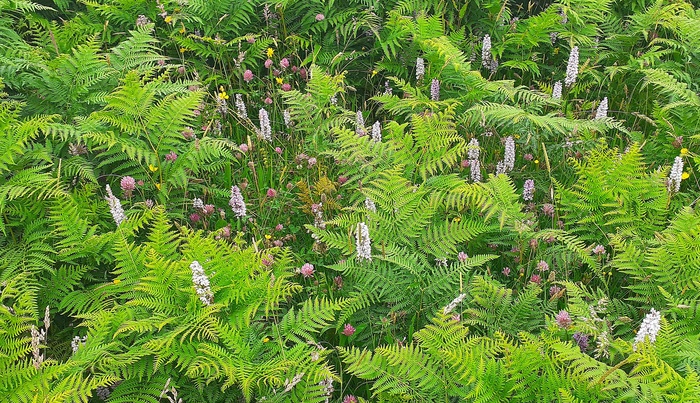
The areas that support these and other wild flowers must be preserved, and the irresponsible mowing and cutting down of roadside verges and other habitats by local councils and other bodies should be stopped by legislation.


It’s been a marvellous year for Buttercups), and everywhere seems to be yellow with these lovely flowers. However, in one particular location where Globe Flowers (a member of the Buttercup family) grow annually.

There is a disappointing display – Odd!
In the Llangasty meadows there are also Greater Knapweed, and just one or two examples of Ragged Robin.

A particular favourite of mine – I just like the name!
I wondered along these meadows early in the morning this week just after sunrise with my landscape lens and took a frame or two because these lovely meadow scenes are few and far between in this area. I got down low because I wanted to frame a tree which is at the top of the meadow on the horizon which I thought added to the scene.

However, in doing this I did get a few insect bites, but that’s all part of the fun!
I have also seen a few other Orchids around during these past weeks.
Southern Marsh Orchid.

Bee Orchid.

Common Spotted Orchids competing with Bracken for light and space.

The areas that support these and other wild flowers must be preserved, and the irresponsible mowing and cutting down of roadside verges and other habitats by local councils and other bodies should be stopped by legislation.
Sedge Warblers Late Fledging.
03rd July 2021
03rd July 2021
Walking alongside the reed beds and associated vegetation at Llangors Lake yesterday in glorious sunshine it was a pleasure to see the birds busily playing catch-up with their breeding activity. This breeding season is at least three weeks later than last year because of the dreadful spring weather we endured here in the ‘Beacons’. There is still a dearth of Butterflies and Dragonflies on the wing, but things should hopefully pick up this month with a bit of warmer weather. I was watching a few pairs of Sedge Warblers bringing a large variety of food back to their nests including, Damselflies, of which there are now many.
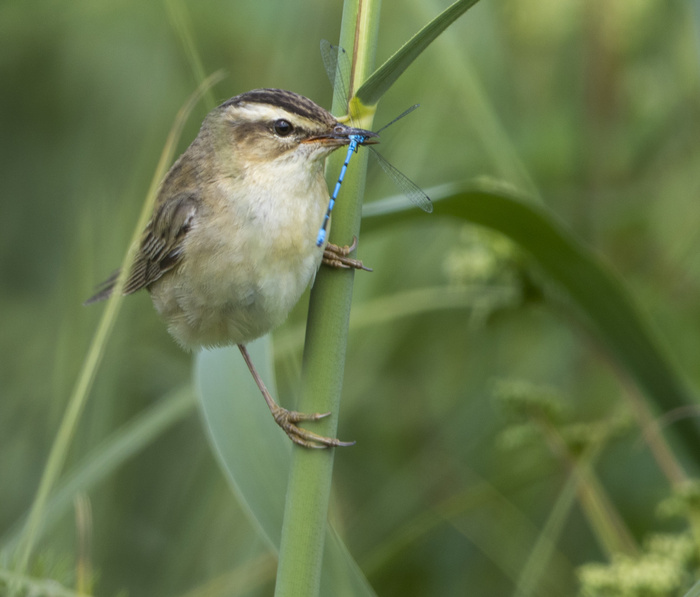
Crane Flies, Caterpillars, Spiders and many more insects that were unidentifiable to me. These birds are not as closely associated to reeds as the Reed Warbler, obviously as the name suggests, and often nest in the low vegetation which borders these reed beds. I was watching from a distance and was able to get a few frames as they hunted for food. It is always an advantage to use a big lens such as the Canon 600 f4 prime with a 1.4 tele converter and a crop sensor camera like the 7D ii which gives a focal length of 1344mm @f5.6. This enables a photographer to stand well back from the birds while still getting a reasonable quality image.
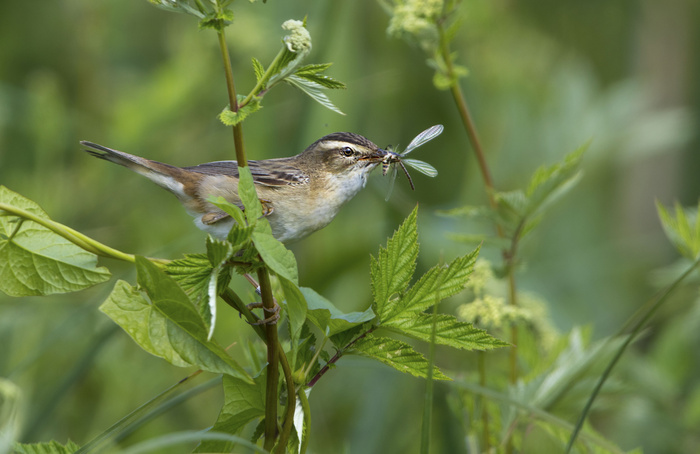
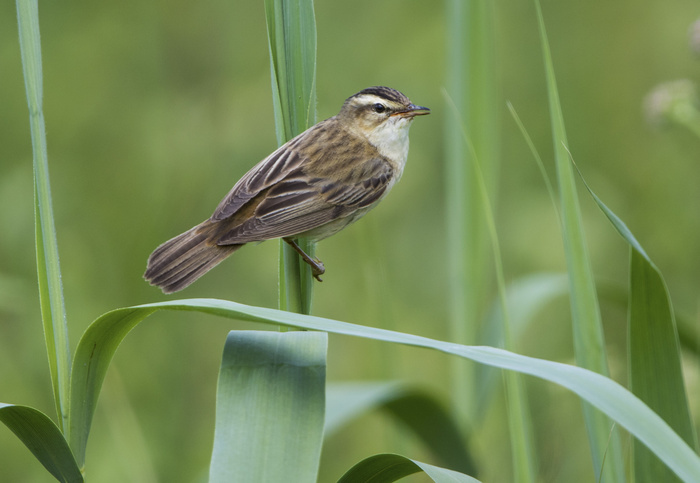

Crane Flies, Caterpillars, Spiders and many more insects that were unidentifiable to me. These birds are not as closely associated to reeds as the Reed Warbler, obviously as the name suggests, and often nest in the low vegetation which borders these reed beds. I was watching from a distance and was able to get a few frames as they hunted for food. It is always an advantage to use a big lens such as the Canon 600 f4 prime with a 1.4 tele converter and a crop sensor camera like the 7D ii which gives a focal length of 1344mm @f5.6. This enables a photographer to stand well back from the birds while still getting a reasonable quality image.


I thought it was all over – but it certainly wasn’t!!
09th June 2021
09th June 2021
Personally speaking it has been a particularly disappointing spring for Cuckoos, the best Cuckoo month in the Brecon Beacons is undoubtedly May and we all know what happened to the weather then! All my best Cuckoo sites were Cuckoo-less, if that’s how you word it. I visited all these hitherto productive habitats a number of times without hearing any calling birds and if Cuckoos are present in May anywhere then they will be calling. It was really cold and grey with frequent showers at these places, but that won’t necessarily put these birds off, they are tougher than people realise. However, the straw that broke the camel’s back was that there was no evidence of the Cuckoo’s primary food – hairy caterpillars. I put the lack of caterpillars down to the aforementioned inclement weather that pervaded during May – record rainfall and the distinct lack of warmth.
I have been driving around the local patch over the last two weeks and while passing through an area where I don’t normally hear Cuckoos I picked up what I thought was a female calling, the females have a soft and delightful ‘bubbling’ call which most people are not familiar with because unlike the male it is not far carrying. I parked up and listened and a repeat call confirmed it, it was fortunate that I heard it because the females don’t call repeatedly like the males. However, that was the easy part because after I pinpointed where she was calling from, a dense willow tree, she was very reluctant to fly from there into the open. I drove away after an hour of no sightings but returned quietly a few days later and surprised her off the grass near the same willow tree where she was feeding on, presumably caterpillars, of which thanks to the now much warmer weather there is a much greater abundance – it’s not rocket science. Frustratingly she once again became ensconced in her willow tree with very little movement and if to frustrate me even further started to call again, which now seemed like mockery. I drove away feeling like an actor in a scene from the film Groundhog Day.
Fast forward to yesterday and the same previous scenario duly played out, so I drove on after a short while to another site to look for other birds, it’s not all about Cuckoos - says the man who can’t photograph one! On my return journey passing through the same site on my way home, I couldn’t believe that I could now hear a male Cuckoo calling, where had he been when I needed him? I drove on and parked on a piece of rough ground off the road. I quickly set my tripod and lens up and unbelievably and without wishing it to sound like a scene from a film again, four Cuckoos were now suddenly flying around me, with one male astonishingly trying to land on my head or lens, I couldn’t tell which because I literally had to drop to the floor to avoid him. The reason for this frenzied behaviour was obviously the female who remarkably had now left the sanctuary of her willow tree and was being pursued by three males. I have always maintained in many previous blogs that this situation is where the photographer has the advantage over Cuckoos, insomuch as this mating frenzy leads to very unpredictable behaviour indeed, and they will frequently perch anywhere, which really is totally out of character for these very street wise birds.
Cuckoos always like isolated trees and bushes and in particular dead ones where they can survey without obstruction the surrounding area. With this in mind I could see a dead hawthorn tree just up the field so I hurried along keeping low behind a dry stone perimeter wall, but already I could see a male perched in this tree, this was disappointing because they will always fly away at the merest sight of people and he was also being harassed by the inevitable Meadow Pipits. Surprisingly he let me get reasonably close and I was able to take a couple of shots.
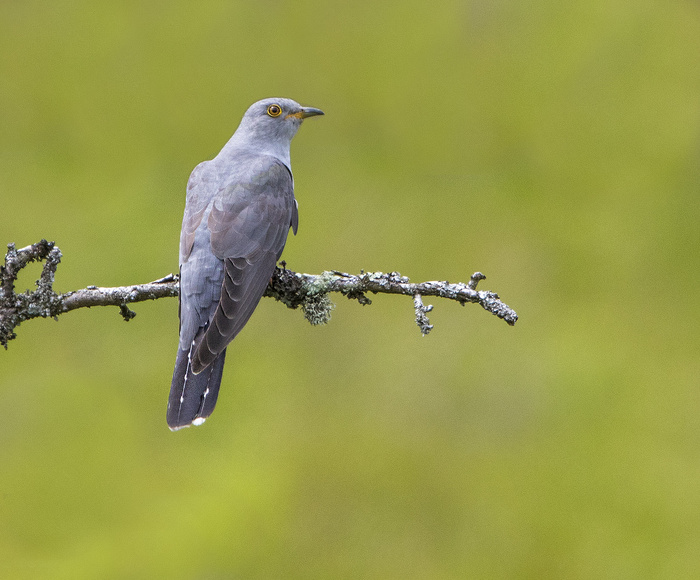
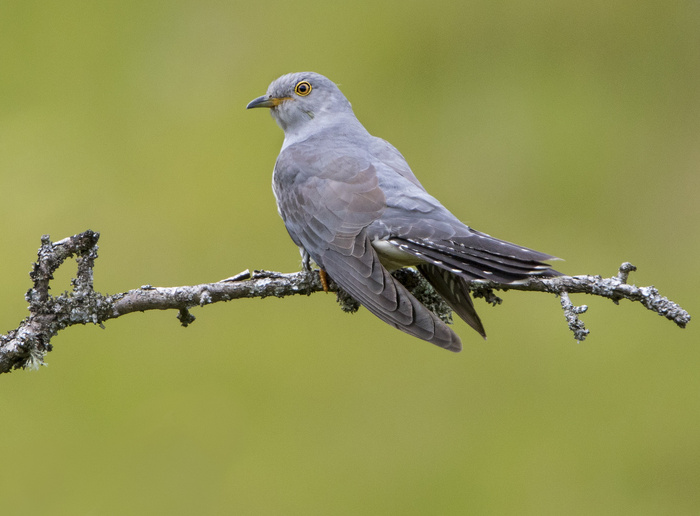
He then looked behind at me before flying off.
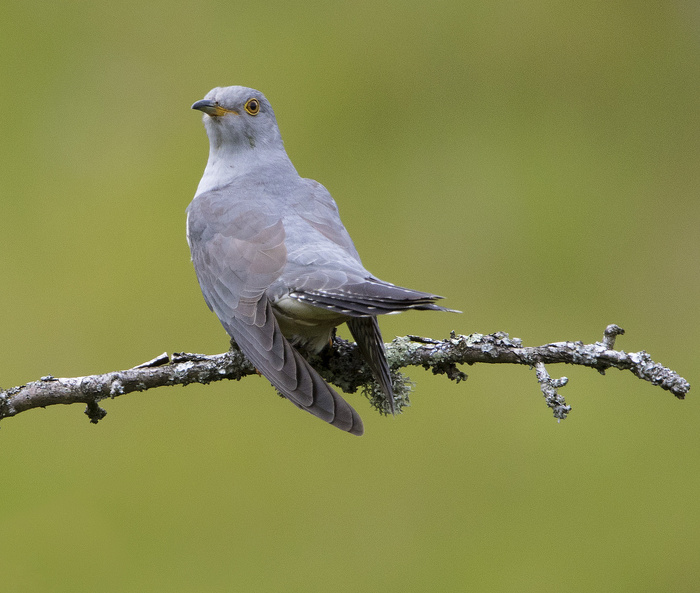
They rarely stay long in this situation.
I moved along and set up and crouched down behind the wall opposite this tree, a bit closer this time, and waited. The hullabaloo continued down field but I sat tight, this is always the best policy, it’s no good chasing around. A Cuckoo came flying up the field and I couldn’t tell if it was male or female until it perched right in the tree and I could now see it was the previously elusive female – at last!
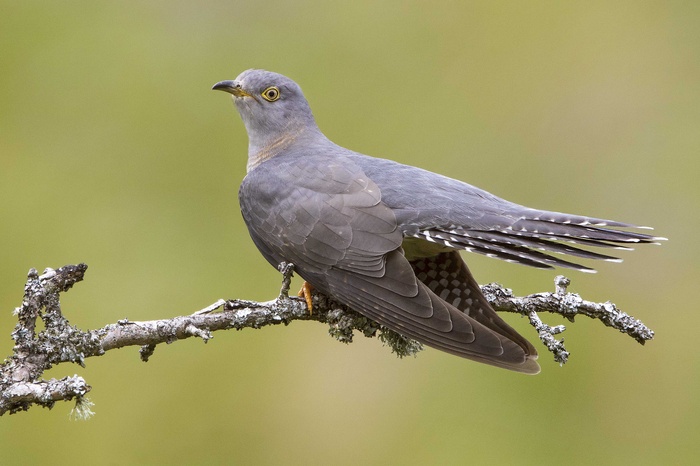
Good things come to those who wait and I had great pleasure in capturing an image of her given her previous shyness. A seemingly lost cause with the shy female had now turned into a photographic opportunity – you never know because it’s not over until the slightly overweight lady sings!
I have been driving around the local patch over the last two weeks and while passing through an area where I don’t normally hear Cuckoos I picked up what I thought was a female calling, the females have a soft and delightful ‘bubbling’ call which most people are not familiar with because unlike the male it is not far carrying. I parked up and listened and a repeat call confirmed it, it was fortunate that I heard it because the females don’t call repeatedly like the males. However, that was the easy part because after I pinpointed where she was calling from, a dense willow tree, she was very reluctant to fly from there into the open. I drove away after an hour of no sightings but returned quietly a few days later and surprised her off the grass near the same willow tree where she was feeding on, presumably caterpillars, of which thanks to the now much warmer weather there is a much greater abundance – it’s not rocket science. Frustratingly she once again became ensconced in her willow tree with very little movement and if to frustrate me even further started to call again, which now seemed like mockery. I drove away feeling like an actor in a scene from the film Groundhog Day.
Fast forward to yesterday and the same previous scenario duly played out, so I drove on after a short while to another site to look for other birds, it’s not all about Cuckoos - says the man who can’t photograph one! On my return journey passing through the same site on my way home, I couldn’t believe that I could now hear a male Cuckoo calling, where had he been when I needed him? I drove on and parked on a piece of rough ground off the road. I quickly set my tripod and lens up and unbelievably and without wishing it to sound like a scene from a film again, four Cuckoos were now suddenly flying around me, with one male astonishingly trying to land on my head or lens, I couldn’t tell which because I literally had to drop to the floor to avoid him. The reason for this frenzied behaviour was obviously the female who remarkably had now left the sanctuary of her willow tree and was being pursued by three males. I have always maintained in many previous blogs that this situation is where the photographer has the advantage over Cuckoos, insomuch as this mating frenzy leads to very unpredictable behaviour indeed, and they will frequently perch anywhere, which really is totally out of character for these very street wise birds.
Cuckoos always like isolated trees and bushes and in particular dead ones where they can survey without obstruction the surrounding area. With this in mind I could see a dead hawthorn tree just up the field so I hurried along keeping low behind a dry stone perimeter wall, but already I could see a male perched in this tree, this was disappointing because they will always fly away at the merest sight of people and he was also being harassed by the inevitable Meadow Pipits. Surprisingly he let me get reasonably close and I was able to take a couple of shots.


He then looked behind at me before flying off.

They rarely stay long in this situation.
I moved along and set up and crouched down behind the wall opposite this tree, a bit closer this time, and waited. The hullabaloo continued down field but I sat tight, this is always the best policy, it’s no good chasing around. A Cuckoo came flying up the field and I couldn’t tell if it was male or female until it perched right in the tree and I could now see it was the previously elusive female – at last!

Good things come to those who wait and I had great pleasure in capturing an image of her given her previous shyness. A seemingly lost cause with the shy female had now turned into a photographic opportunity – you never know because it’s not over until the slightly overweight lady sings!
The Garden Warbler - a top singer.
25th May 2021
25th May 2021
The Garden Warbler is one of the top singers that arrive in the UK in spring. However, getting good views of this songster is another matter. They can be particularly difficult to see out in the open, they dart around a dense copse or line of trees singing continually but not keeping still for too long. They have a gentle appearance with few prominent features to help with identification. The two salient ID points are the white eye ring and grey nape. The best way to locate them is by their song, but even this to the untrained ear can be difficult, being easily confused with the Blackcap, another top songster. However, with practice the Blackcap is flutier with more mellow notes and in addition the Garden Warbler’s song usually lasts longer than the Blackcap’s and is quicker and more staccato like. Early this morning I was walking near a small woodland when I could hear at least two Garden Warblers singing vociferously and as I got closer I could see that there were two birds having a singing competition announcing their territories. One bird was very close so I set up and waited in hope for a clear shot and after many failed attempts I finally located it singing from a branch out in the open.
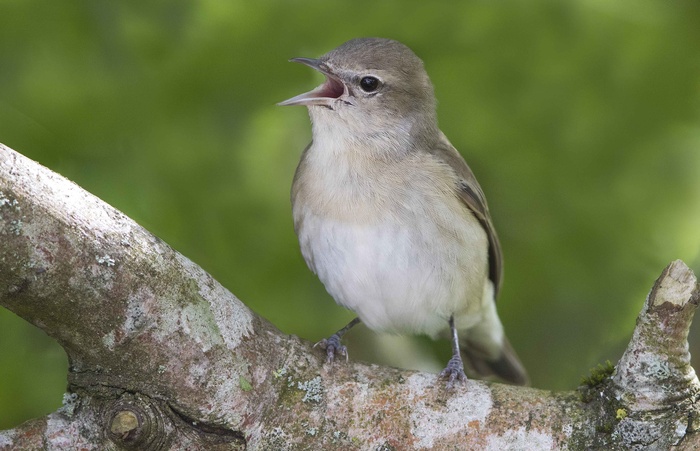
I managed a few more quick shots from different perches before it went quiet.
In the image below you can clearly see the white eye ring and grey nape patch.
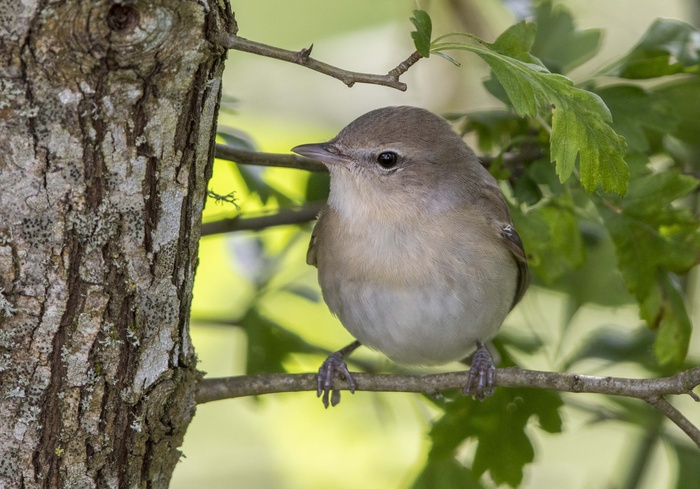
Unfortunately but predictably the rain showers started to fall again so I retreated back to the car and called it a day - Oh for some settled weather and a bit of warmth.
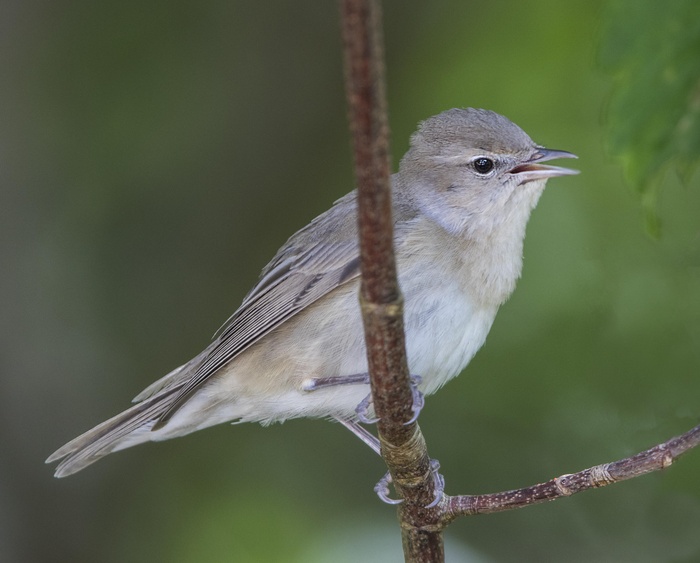

I managed a few more quick shots from different perches before it went quiet.
In the image below you can clearly see the white eye ring and grey nape patch.

Unfortunately but predictably the rain showers started to fall again so I retreated back to the car and called it a day - Oh for some settled weather and a bit of warmth.

The Monsoon Continues.
21st May 2021
21st May 2021
This appalling spell of stormy weather is still persisting here in the Brecon Beacons. Very strong winds and near record rainfall is ruining my favourite time of year. The apple blossom on the trees in our garden is getting battered and waterlogged and there is a marked lack of pollinators, in particular bees. It doesn’t look promising for the apple crop this autumn. Our runner beans which were planted late because of heavy frosts are hardly moving, suffering from a distinct lack of sunshine. Butterflies are not on the wing, we’ve only seen a few Orange Tips, a solitary Green Veined White and a battered Peacock - very poor for late May. I have only heard two distant Cuckoos and there are no sightings at two of my local sites – it’s quite depressing really. Thankfully all the usual spring migrants are here, enduring the weather and yesterday a few Hobbies were reported from a local lake.
We noticed a marked increase in Drinker Moth caterpillars in the roadside vegetation earlier this week.
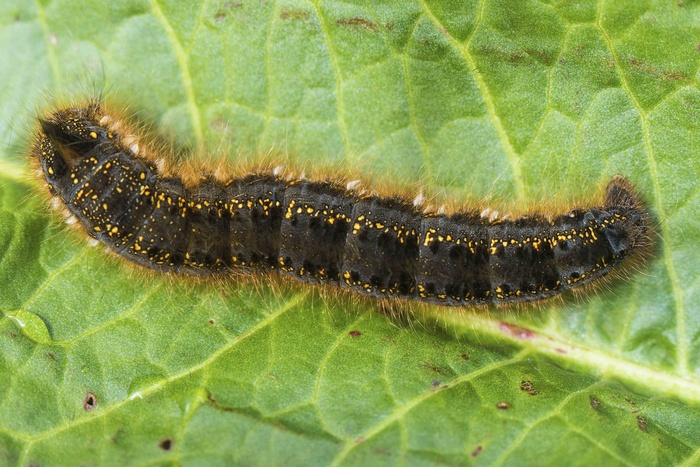
Image below taken with - (Canon 7Dii and Canon EF100 f2.8 is Macro Lens with Yongnuo twin macro flash).
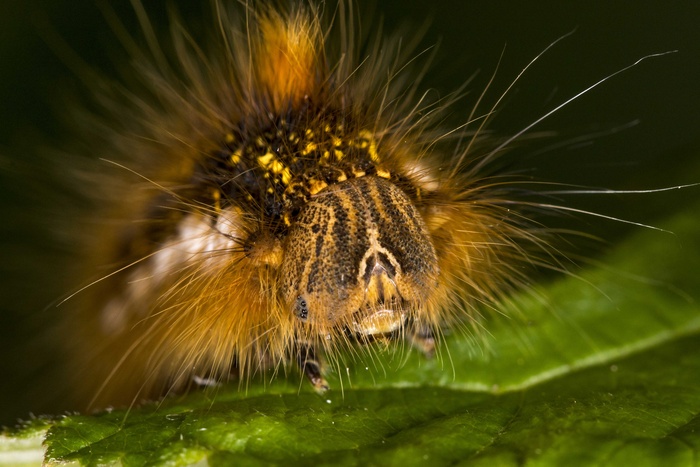
This hairy caterpillar is one of the Cuckoo’s favourite foods.
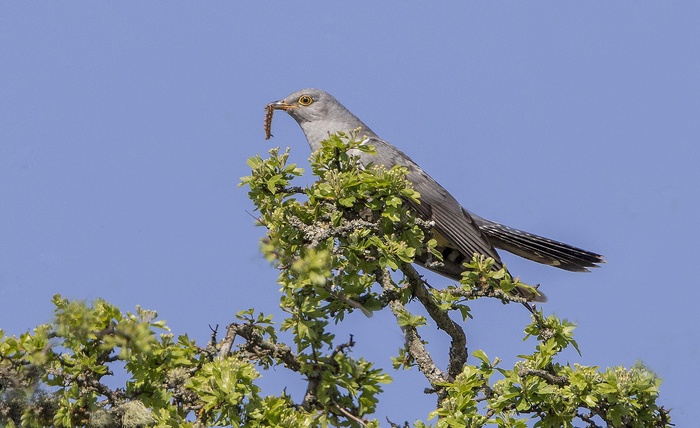
So I hope this is a good omen. The weather forecast is tentatively hinting at drier weather for next week so I’m hoping that will entice a few Cuckoos to my upland sites, nothing is guaranteed in nature but I’m keeping my fingers crossed.
We noticed a marked increase in Drinker Moth caterpillars in the roadside vegetation earlier this week.

Image below taken with - (Canon 7Dii and Canon EF100 f2.8 is Macro Lens with Yongnuo twin macro flash).

This hairy caterpillar is one of the Cuckoo’s favourite foods.

So I hope this is a good omen. The weather forecast is tentatively hinting at drier weather for next week so I’m hoping that will entice a few Cuckoos to my upland sites, nothing is guaranteed in nature but I’m keeping my fingers crossed.
Yellowhammer - a rare visitor to our garden.
07th May 2021
07th May 2021
Over the last week there has been a Yellowhammer perched in a hawthorn hedge just outside our garden singing all day long. He’s at it from dawn to dusk singing for a mate, but I don’t fancy his chances much because Yellowhammers are an uncommon bird where we live. Nevertheless it’s always nice to hear his well-documented song – ‘A little bit of bread and no cheese’. However, yesterday he decided to fly over the hedge into the garden and I was lucky enough to be sat in my permanent bird hide at the time.
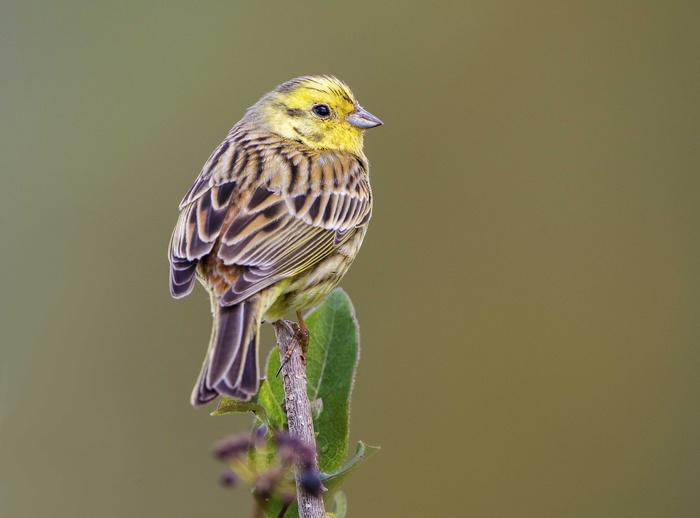
It’s a very rare occurrence for this to happen, probably only three times in twenty odd years.
He perched in various positions - in some ivy.
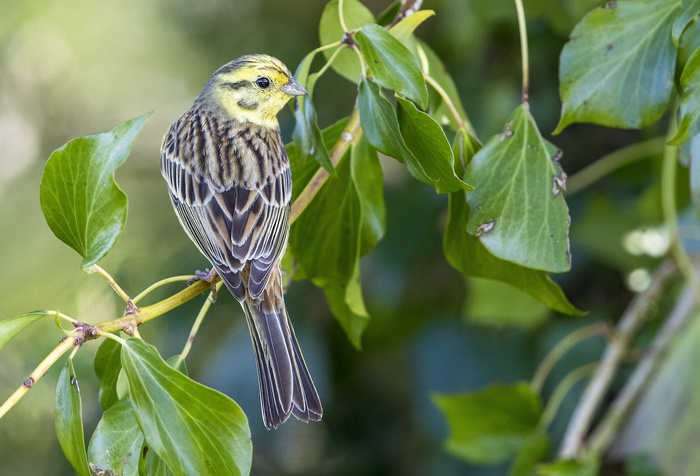
And looking for food among the grass and flowers.
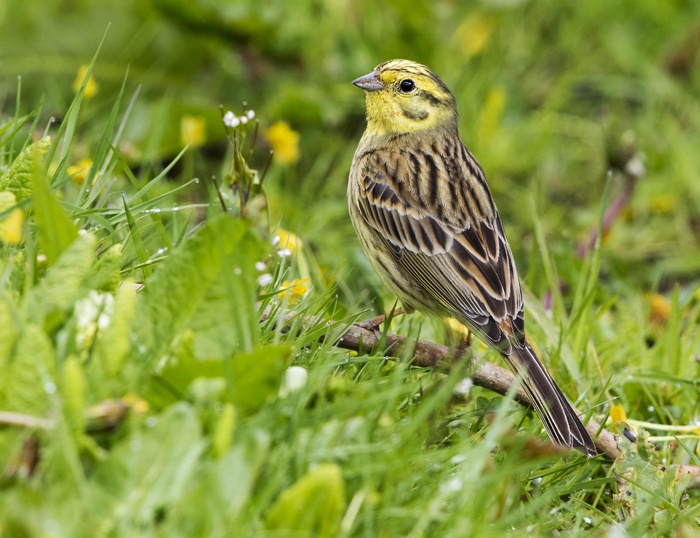
I also took a quick video of him singing,
https://youtu.be/JFUAsfE_gr4
They are such a nice little bird and are welcome anytime.

It’s a very rare occurrence for this to happen, probably only three times in twenty odd years.
He perched in various positions - in some ivy.

And looking for food among the grass and flowers.

I also took a quick video of him singing,
https://youtu.be/JFUAsfE_gr4
They are such a nice little bird and are welcome anytime.